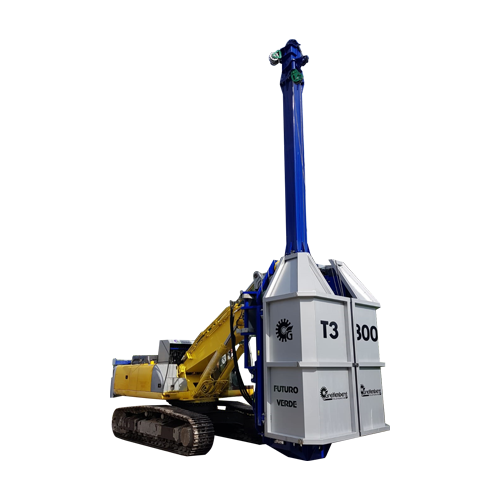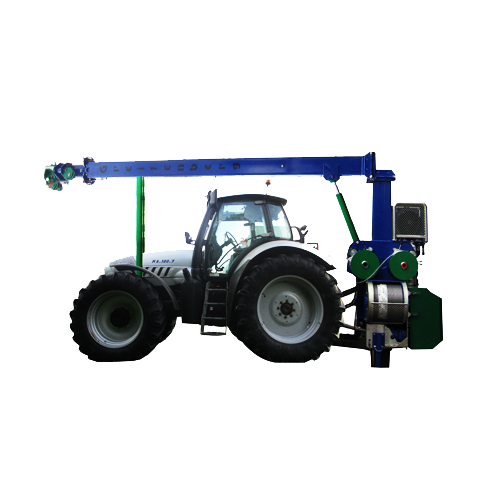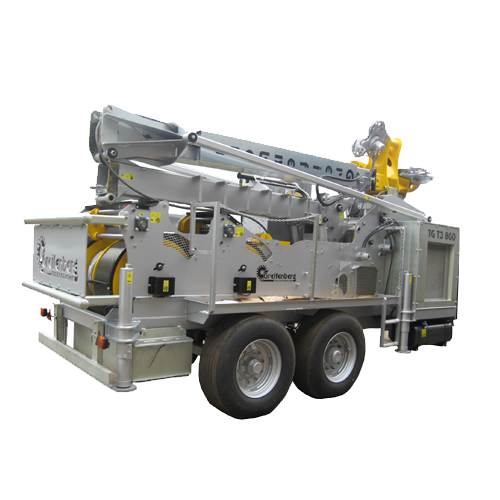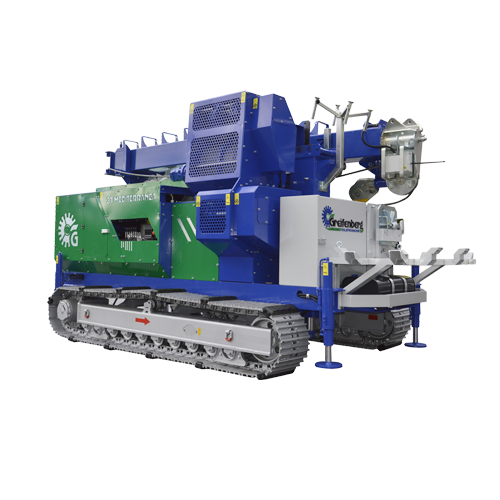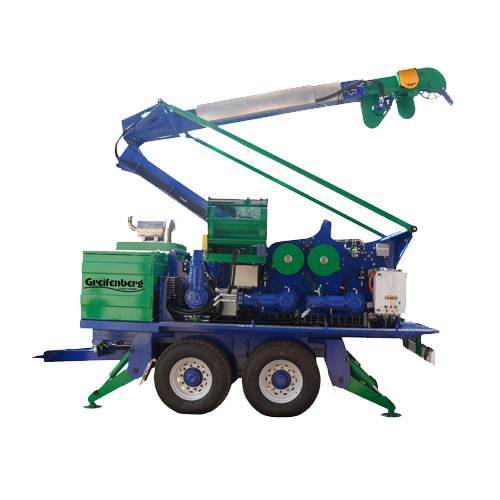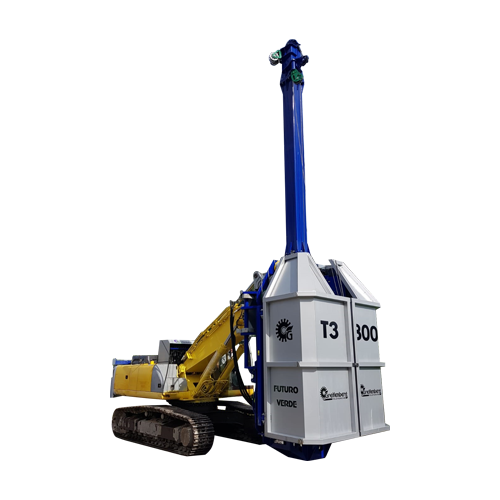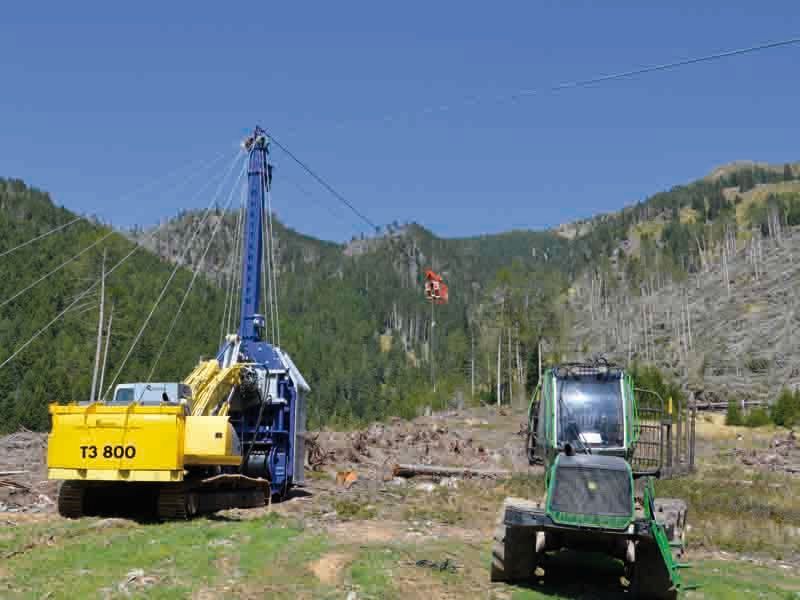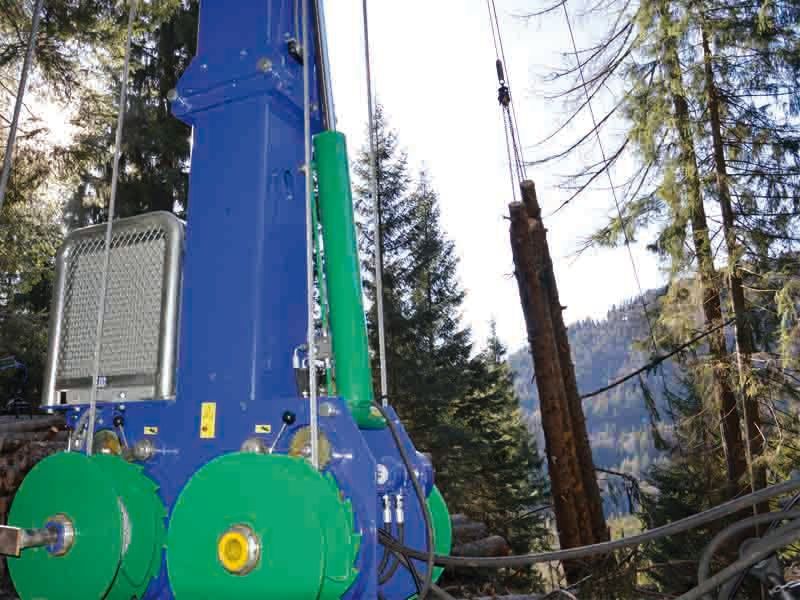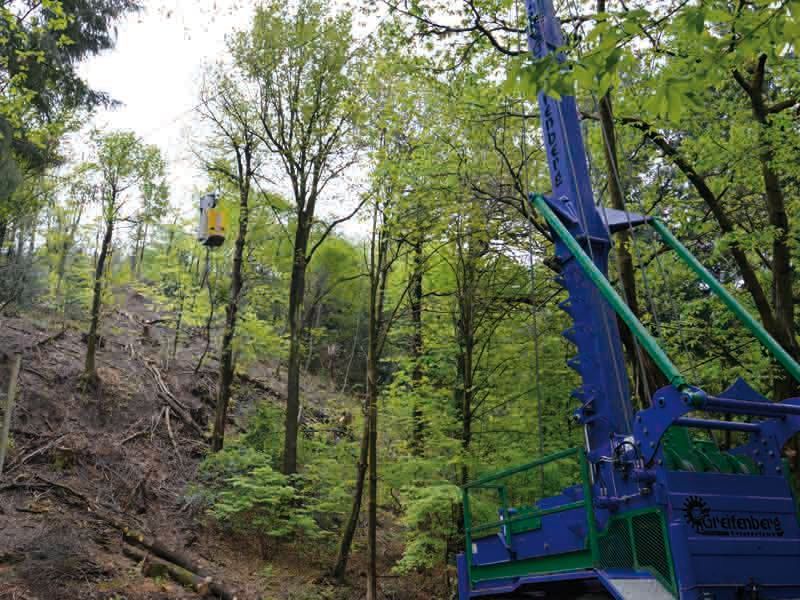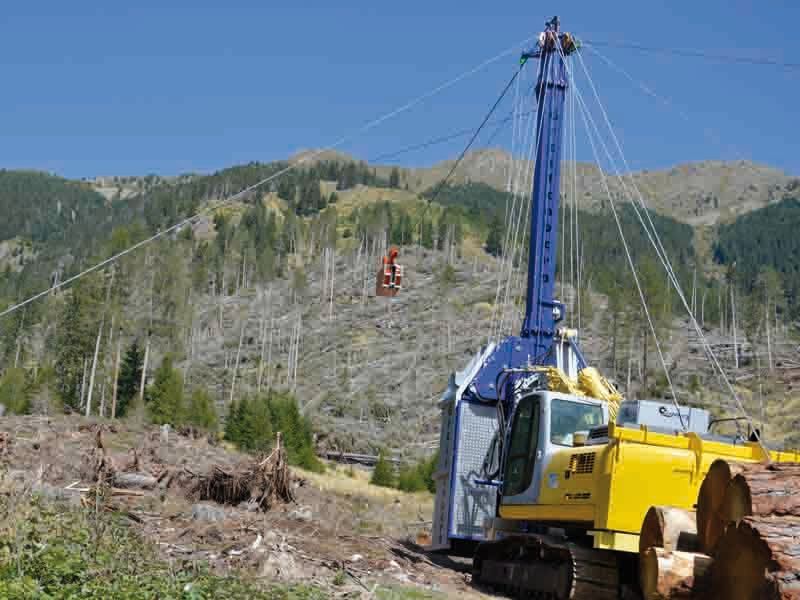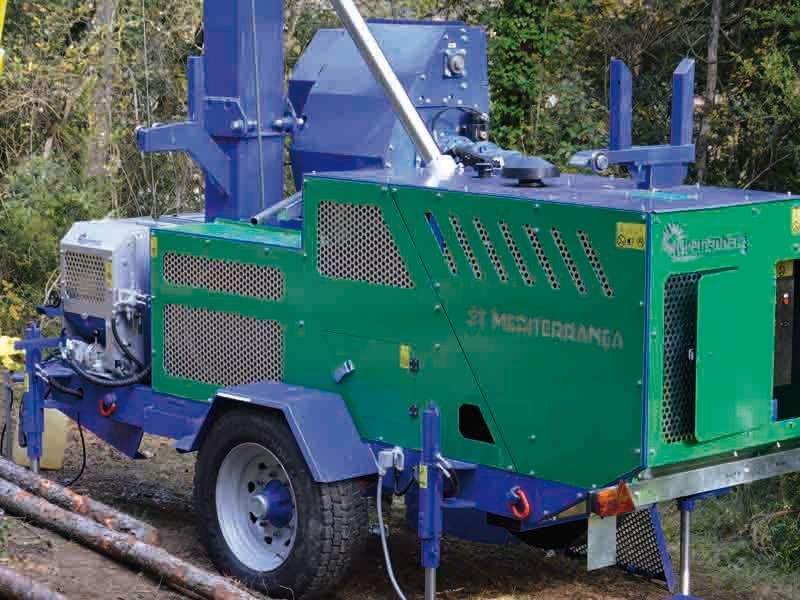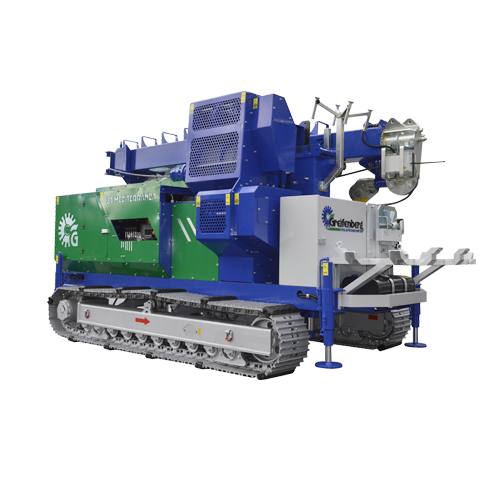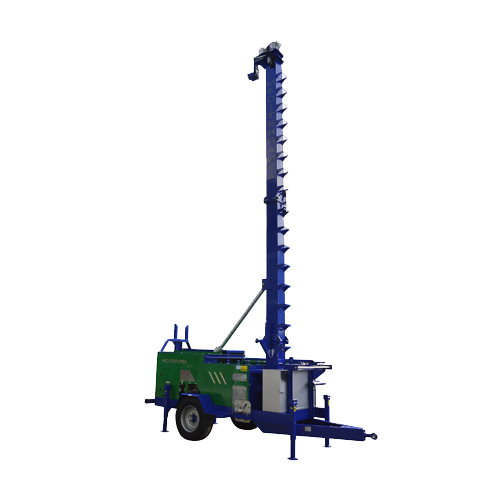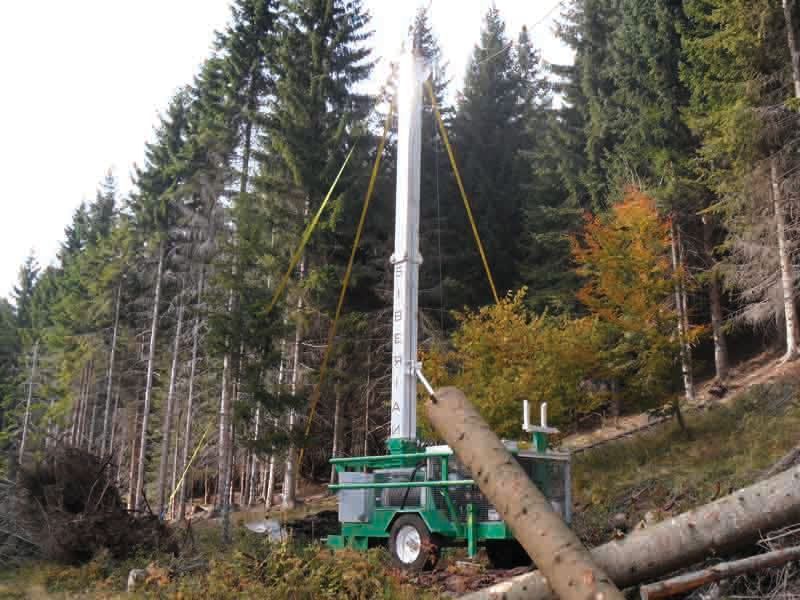Advanced Solutions for Handling in Every Environment
Innovation and reliability for your work
Three-drum models for ring lines, two-drum models for gravity work, single drum models for carrier rope tensioning. Mounted on wheeled frames, tracked units, and lorries. Lines from 500 to 1100 metres. Hydraulic models, electronically controlled, radio-controlled, with automatic cycles and hybrid systems. Power ranges from 50 to 300 horsepower, with pulling forces from 1.8 to 5 tonnes.
Excavator Three-Drum Cable Car
Load capacity: 4000 kg
Lines up to 800 m
This three-drum cable car is not equipped with its own internal combustion engine; instead, it must be installed on an excavator to utilise its power source. It is the ideal solution for those who are familiar with excavators or civil/building machinery. With this system, it is possible to equip large excavators, taking advantage of their diesel engine, hydraulic transmission, and mobility. A swivel is installed on the excavator arm to horizontally position the cable car, while the quick attachment allows for rapid disconnection of the cable car from the excavator during transport. The versatility of the excavator enables the cable car to be positioned in difficult locations such as roadside ramps, steep slopes, etc. The four bracings can be directly connected to the excavator’s ballast, while the two outer ones can be connected to external elements for lateral stabilisation if necessary. The carrier rope system allows the machine to operate in "swing yarder" mode, using the carriage with an American-style log grapple. This machine can be equipped with all the optional features of a traditional cable car and can also be customised in accordance with the technical office.

A 11.000 mm
B 2.360 mm
C 2.850 mm
| TECHNICAL DATA | |
|---|---|
| Frame mounted on | Excavator |
| Excavator weight | 40 ton |
| Hydraulic system | Power supply from excavator circuit |
| Control management | Electronics |
| Bracings | No. 6 x 80 m Ø18 mm |
| Bracing | No. 6 x 80 m Ø18 mm |
| Indicative dry weight | 18 ton |
| CARRIER ROLLER | |
| Rope capacity | 800 m |
| Rope diameter | 24 mm |
| Pulling force first layer | 16000 daN |
| Maximum speed | 1,2 m/sec |
| TOWING ROLLER - RECOVERY | |
| Rope capacity | 800 m - 1600 m |
| Rope diameter | 12 mm |
| Pulling force first layer | 4700 daN |
| Pulling force last layer | 4000 daN |
| Maximum speed | 4 m/sec |
Radio System
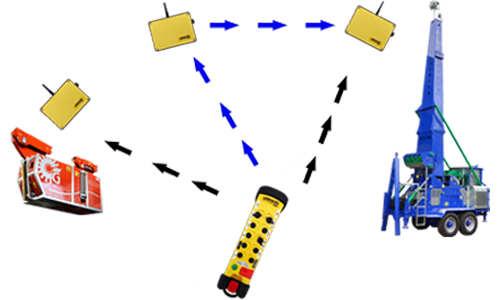
The radio controls adopted by Greifenberg are the result of years of field experience in terms of operational range and ergonomics. They are comfortably usable with safety gloves and feature an extremely robust "case" capable of withstanding falls and violent impacts. With a convenient shoulder strap, they can be held with one hand, and thanks to buttons marked with specific icons, manoeuvres during use are extremely simple. A powerful battery ensures a full working day of use. Additionally, the standard supply includes a spare battery and a charger. The "brain" of the radio system is located in the key inserted into the remote control, where codes and communication protocols are stored.
From the remote control, all manoeuvres typically performed on the machine's touch screen panel can be carried out. In fact, it is possible to switch the diesel engine on and off, increase and decrease the speed of the ropes, set and update the end line or load point, make moves outside the set parameters via the dedicated "by-pass" button, start the automatic working cycle for the machine to operate autonomously, control traditional trolleys by opening and closing the blocks on the ropes, and also perform all manoeuvres on motorised trolleys, controlling both the motor and the lifting and lowering speed. Through the remote control, the maximum lifting point of the trolley can be set so that the hook is not mistakenly lifted too high, as well as the maximum unwinding of the rope, preventing the entire rope from being unwound from the trolley's drum. If the rope is shortened, the maximum lifting point can be reset to reflect the new rope length. The same remote control can also integrate the management of Fortronics electronic chokers with an accidental opening prevention system.
The Radio System includes a perfectly coded and integrated frequency repeater. The radio controls can operate with one or more repeaters, extending the working distance indefinitely and allowing the system to overcome bumps, buildings, and obstacles of any kind, thus extending operational distances. The repeater is housed in a compact and robust casing, and inside it, a powerful rechargeable battery ensures operation even during an intense working day. The repeater must be placed at the tops of bumps or alongside structures to ensure good interconnection with both the transmitter and receiver. The simple activation is performed via a single button, and the distance is reset with one click.
Greifenberg understands external working conditions, with temperatures ranging from below zero to scorching sun, snow, water, and humidity. The Radio System is unaffected by the elements: IP 65 class, selected components, and contacts treated with anti-oxidant materials—these are the guarantees of a product designed for tough tasks. Maximum reliability to ensure precise, timely, and indisputable control. Transmitters, repeaters, and receivers are ready for work without interruption.
Ejector

The ejector of the pulling cable ensures that the cable remains taut on the drum in such a way that no slack is created, which could compromise the correct winding and durability of the cable. This means that the pulling cable is redirected to a motorised pulley, which guarantees that the correct tension is always maintained between the roller and the pulley, safeguarding the integrity of the steel cable. The pulling cable continuously travels thousands of kilometres between the "wind" and "unwind" functions. For this reason, the pulley is made of special steel and thermally treated, and the hydraulic motor applied is suitable for intensive work.
The traction force on the cable is adjustable to ensure sufficient extraction force and reduce fuel consumption. A traditional extraction pulley on a cableway can absorb up to 10/15 horsepower, affecting fuel consumption by up to 8% of the machine's daily fuel usage. The adjustment of the opposing force and hydraulic pressure helps reduce these values, lowering fuel consumption and harmful emissions.
In cases where the work is carried out on steep slopes or medium-length tracks, it is possible, via a control panel command, to disengage the pulling ejector system and use the pulley as a simple idle pulley with minimal friction.
This system can operate at up to 10 metres per second of pulling cable speed, so even in very long and flat stretches where the catenary of the pulling cable becomes very pronounced, there is no issue on the roller. Even at high speeds, it guarantees the maximum preload on the pulling cable.
Automatic Cycle
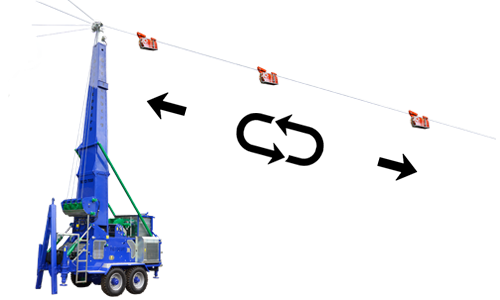
ATG, Automatic Travel Greifenberg, is the electronic control and management system, a true form of artificial intelligence, meaning the machine's ability to travel on a cable fully autonomously and in automatic cycle. The ATG system considers various critical points, such as supports, potential load entanglements, excessive power demand when climbing, overspeed during descents, deceleration and acceleration speeds, and the update of the loading point when necessary. It constantly coordinates the operation with reactivity, precision, and accuracy.
To activate the ATG, it is necessary for the machine to recognise the two extreme points of the line, which are stored as the "start of the line" and "end of the line" using an intuitive procedure on the control panel. Subsequently, it will be possible to store the points along the line where the supports are located, which will be interpreted as sensitive points. To achieve smooth translation, the electronic system allows setting the distance from the support at which we want to decelerate and the distance after passing it at which we want to accelerate again and return to normal speed. The distances and the amount of deceleration can be entered differently depending on which part of the journey is being made and, consequently, how the machine enters the supports. In fact, when transporting heavy loads downhill, it is necessary to gradually slow down at an appropriate distance, while after passing the support, the speed is quickly regained to avoid cable and load oscillations. Conversely, if the transport is going uphill, it is sufficient to slow down just before the support, as the weight and gravity already provide additional deceleration.
Everything is under control during the journey. In fact, the machine, thanks to its pressure transducers and position encoders, constantly monitors the effort, and if it detects abnormal peaks (caused by jamming or friction), it deactivates the automatic system, stopping the journey but always making the manual mode available. The ATG function also allows updating the loading or unloading point via the radio control. When the transport frequently needs to change the destination point to pick up or deposit material in different locations, it is sufficient to directly activate the "store new end point" function via the remote control, and the machine will stop exactly at the determined location.
Smart Yarder
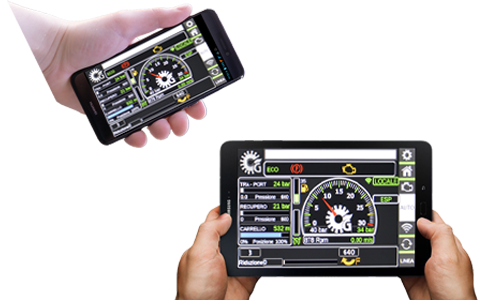
Information is everything. The “Smart Yarder” function, in addition to keeping you informed about everything your machine is doing, allows you to interact remotely directly from your smartphone, tablet, or PC. Smart Yarder faithfully replicates everything that the Greifenberg infotainment system communicates via the machine’s touch screen panel. Every single piece of information is transmitted and faithfully mirrored on your device. But that’s not all – it is also possible to write or modify settings and work programmes. A "mirroring" system that duplicates the command point without the need to access the machine. This innovation has been introduced particularly to facilitate the adjustment of work parameters and to monitor the machine's status, such as the engine's RPM, fuel level, or AdBlue level. Access to this function is secured by a password to prevent unauthorised access. Simply activate the Wi-Fi function on your portable device and enter the secret code.
The machine, thanks to a powerful router with a transmitting antenna, maintains a constant connection within a radius of approximately 50 metres. The use of this function is particularly appreciated by those operating both Greifenberg equipment and another vehicle such as a tractor, skidder, harvester, or excavator. No more getting in and out of your vehicle! Online controls, checks, and parameter adjustments allow you to remain at your command station, increasing comfort and productivity.
Display Tourch Screen
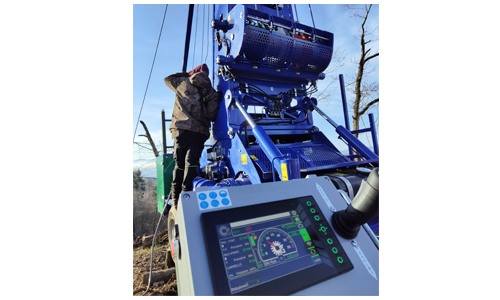
This type of display is at the top of performance in terms of technology and reliability. It is resistant to weather conditions such as rain and snow. It offers high brightness to ensure excellent visibility even when exposed to sunlight, with outstanding definition and realistic colours that facilitate readability even at very oblique viewing angles. The touch screen is patented to be used even with gloves. Additionally, all work menus can be accessed via physical buttons to change the screen view. Every process is under control. It allows the visualisation of data and the setting of machine parameters with maximum flexibility. From the control display, it is possible to select the engine power, view fuel and AdBlue levels, hydraulic system pressure, the speed and position of the carriage, the position and speed of each roller, check the brake status, identify which roller is active, view alarms, check the machine’s maintenance status, and much more. The line parameterisation can be entered with factory data or customised in every detail. For example, the deceleration during the crossing of the shoes can be detailed according to the direction of entry, whether uphill or downhill, and programmed both in terms of distance and deceleration percentage. Infinite possibilities of use, intuitive, fast, and adaptable to different situations to tackle every type of daily activity.
Safety Device
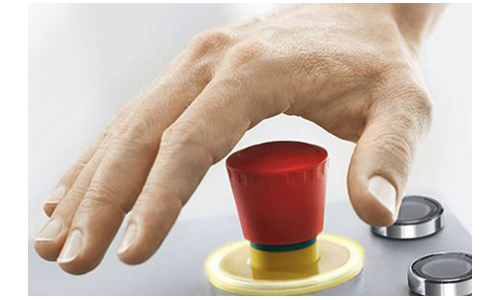
The cable cars, in the electronic safety management system, have the function of forced and preset slackening of the carrying cable. This function allows the operator, by pressing a button labelled "carrying cable lowering", to activate an autonomous system for converting hydraulic flows, accelerating the engine, and moderately activating the hydraulic pumps. This mode prevents any possibility of the carriage colliding with the end of the line. The carrying cable lowers until the load being transported makes contact with the ground, stopping any uncontrolled movement. The operator who activates the function, after pressing the button, can move away and ensure their safety. The machine will autonomously carry out the manoeuvre.
Backup Alarm
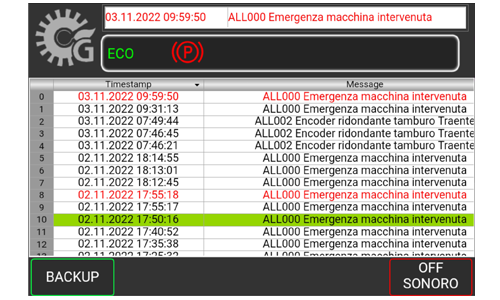
Total control, verification, and statistics. Every alarm, abnormal use, and operation outside the set parameters are automatically recorded and stored in a dedicated memory. Data such as engine overspeed, overpressures, overspeed, oil and water temperature alarms, etc., are immediately recorded. It will be easy for the owner to monitor how the machine is being used, both by their own employees and in the case of renting to third parties. Even for interventions by the technical service, everything becomes faster, reducing management costs. Information dedicated to longevity and maintenance.
Remote Assistance.
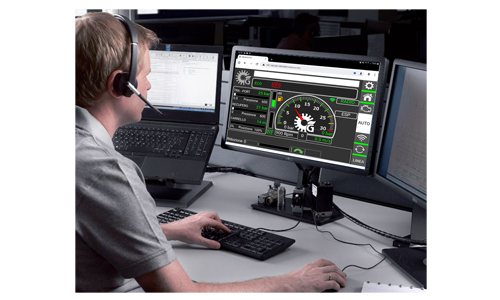
Our technicians are with you, whenever you want, on your site to help you solve problems. Through remote assistance, simply activate a GPRS connection and allow access to your equipment. This always and exclusively happens with the operator’s authorisation on the machine. Once connected, our electronic and hydraulic technicians can work on the machine as if they were on-site. Maximum intervention speed and reduced costs and waiting times. The innovation of safety always by your side.
Syncro System
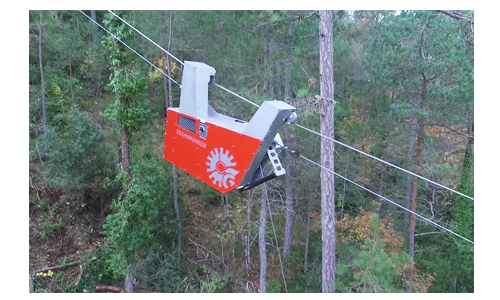
This technology is a sophisticated software that manages the perfect synchronisation of the cables in systems with a loop operation. Syncro System controls the tension of the cables and continuously adjusts the speed of the drums in an automated manner. The parameters of cable speed, hydrostatic transmission pressure, rotational speed of the drums, and engine RPM are continuously analysed and compared at a speed of 10 milliseconds. The electronics manage a multitude of input variables to generate a signal for the control of the hydraulic transmissions. Everything occurs autonomously and automatically, and the operator can control the machine either in manual mode or in "automatic cycle" mode, with every action always under control. Absolute simplicity, smooth variations without jolts, no more slack cables, and smooth starts and stops – this is the Greifenberg Syncro System.
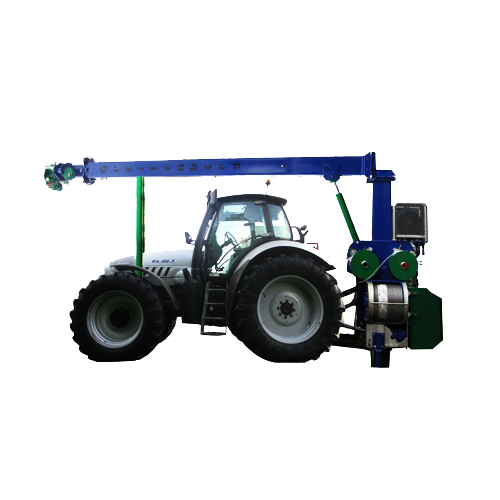
Load capacity 6000 kg, Radio-controlled
The TG 430 is equipped with a three-point attachment for the tractor’s lifter. For this reason, it proves to be fast in assembling and disassembling lines, combined with ease of use that reduces the learning time for personnel. The cable car is complete with a carrying roller, a pulling roller, and 4 stays for the construction of the line up to 430 metres. The tower can be fitted with an additional hydraulic section to increase its height and is easily foldable within the outline of the tractor for road transport. Services such as stays and tower movement are hydraulically managed on the machine, while the movement of the rollers is electrically/electronically controlled with the standard remote controls. The management system is optimised by the presence of a computer where the line can be set, allowing the machine to operate automatically without an operator present. It can also be equipped with "Greifenberg Technology," offering customisation with multiple options that shape a product made "in series" but optimised according to the customer's choices.

A 6.550 mm
B 3.100 mm
C 1.600 mm
D 11.000 mm
E 7.500 mm
F 1.100 mm
Indicative weight with cables
4 ton
| TECHNICAL DATA | |
|---|---|
| Frame mounted on | Tractor lifter |
| Drive | PTO drive shaft |
| Hydraulic system | Closed circuit |
| Control management | Electronics |
| Hydraulic system | Closed circuit |
| Control management | Electronics |
| Bracings | no. 4 x 80 m Ø 14 mm |
| CARRIER ROLLER | |
| Rope capacity | 430 m |
| Rope diameter | 18 mm |
| Pulling force first layer | 8900 daN |
| Maximum speed | 2 m/sec |
| TOWING ROLLER - RECOVERY | |
| Rope capacity | 430 m |
| Diametro fune | 10 mm |
Radio System

The remote controls adopted by Greifenberg are the result of years of field experience regarding operational range and ergonomics. They can be comfortably used with safety gloves and feature an extremely robust "case" capable of withstanding drops and violent impacts. With the convenient shoulder strap, they can be held with one hand, and thanks to the buttons marked with specific icons, operations during use are extremely simple. A powerful battery ensures a full day's work, and additionally, the standard supply also includes a spare battery and a charger. The brain of the radio system is located in the key inserted into the remote control, where communication codes and protocols are stored.
From the remote control, all the maneuvers normally performed from the machine's touch screen can be carried out. For instance, it is possible to turn the diesel engine on and off, increase and decrease the speed of the cables, set and update the end-of-line or loading point, perform movements outside the set parameters using the dedicated "bypass" button, start the automatic work cycle for autonomous operation, control traditional carriages by opening and closing the locks on the cables, and also perform all maneuvers on motorised carriages by controlling both the motor and the lifting/lowering speed.
Through the remote control, it is possible to set the maximum lifting point of the carriage so that the hook is not accidentally lifted too high, as well as the maximum unwinding of the cable, preventing the entire cable from being unwound from the carriage drum. If the cable is shortened, it is possible to reset the maximum lifting point, updating it to the new cable length. The same remote control can also integrate the management of Fortronics electronic chokers with an anti-accidental opening system.
The Radio System includes a perfectly coded and integrated frequency repeater. The remote controls can operate with one or more repeaters, allowing the working distance to be virtually unlimited, and most importantly, capable of overcoming bumps, buildings, and any kind of obstacle, extending the operational range. The repeater is housed in a small, durable casing, and its powerful rechargeable battery ensures operation even on long workdays. The repeater should be placed at the peaks of bumps or beside structures to ensure a good connection both to the transmitter and receiver. The activation is very simple and is carried out by a single button, with the distance being reset with one click.
Greifenberg understands the external working conditions, with temperatures ranging from below freezing to scorching sun, snow, water, and humidity. The Radio System is not affected by the weather: with an IP65 rating, selected components, and contacts treated with anti-oxidant materials; these are the guarantees of a product designed for heavy-duty applications. Maximum reliability ensures precise, timely, and indisputable control. Transmitters, repeaters, and receivers are ready for non-stop work.
Ejector

The hauling rope ejector manages to maintain tension on the rope on the drum in such a way that it prevents slackening, which could compromise the correct winding and the rope's longevity. This means that the hauling rope is redirected onto a motorised pulley, which ensures that there is always the correct tension between the roller and the pulley, safeguarding the integrity of the steel cable. The hauling rope continuously travels thousands of kilometres between the "wind" and "unwind" functions; for this reason, the pulley is made from special steels and is heat-treated, while the hydraulic motor applied is suitable for intensive work.
The traction force on the rope is adjustable to ensure sufficient extraction force and reduced fuel consumption. A traditional extraction pulley on a cable car can absorb up to 10-15 horsepower, affecting fuel consumption by up to 8% of the machine's daily fuel usage. The adjustment of the counterforce and hydraulic pressure allows these values to be halved, reducing both consumption and harmful emissions.
In cases where the work is carried out on steep slopes and medium-length routes, it is possible, via a control on the panel, to deactivate the hauling ejector system and use the pulley as a simple idler pulley with minimal friction.
This system can operate at up to 10 metres per second of hauling rope speed, so even in cases of very long and flat stretches where the sag of the hauling rope becomes pronounced, there is no issue with the roller, even at high speeds, ensuring maximum pre-tensioning on the hauling rope.
Automatic Cycle

ATG, Automatic Travel Greifenberg, is the electronic control and management system, a true form of artificial intelligence, meaning the machine’s ability to perform rope travel entirely autonomously and in automatic cycle. The ATG system considers various critical points, such as the supports, possible load jams, excessive power demand during ascent, over-revving on descents, deceleration and acceleration speeds, and updates the loading point if necessary. It constantly coordinates the work with responsiveness, precision, and accuracy.
To activate the ATG, it is necessary to have the machine recognise the two end points of the line, which are saved as "start of line" and "end of line" through an intuitive procedure on the control panel. It is then possible to save the points along the line where the supports are located, which will be interpreted as sensitive points. To achieve a smooth translation, the electronic system allows you to set the distance from the support at which you want to decelerate, and at what distance, after passing the support, you want to accelerate again and return to normal speed. The distances and the amount of deceleration can be entered differently depending on which part of the journey is being undertaken and, consequently, the entry onto the supports. In fact, when transporting heavy loads downhill, it is necessary to gradually slow down at a proper distance, whereas, after passing the support, speed is quickly regained to avoid rope and load oscillation. On the other hand, if the transport is uphill, it is sufficient to slow down close to the support as the weight and gravity naturally increase the deceleration.
Everything is under control during the journey; in fact, the machine, thanks to its pressure transducers and position encoders, constantly monitors the effort. If it registers any abnormal peaks (caused by jams or resistance), it deactivates the automatic system, stopping the journey but always leaving the machine available in manual mode. The ATG function also allows for the update of the loading or unloading point via the radio control. When the transport needs to frequently change the arrival point to pick up or deposit material in different locations, simply activate the "store new end point" function directly from the remote control, and the machine will stop exactly at the predetermined location.
Colour Display

The colour display for machine data and line data offers greater accessibility, enhanced intuitiveness at first glance, ease of line parameterisation, and a simplified procedure for synchronising the remote controls of the trolleys. The new series of displays allows for quick checks, constantly informing the operator about position, efforts, shoe positions, engine revolutions, fuel consumption, and fuel levels. The most relevant data are displayed both in analogue and digital formats to increase the immediacy of reading.
Safety Device

The cableways, in the electronic safety management system, have the function of forced and preset loosening of the supporting cable. This function allows the operator, by pressing a button called "support lowering", to activate an autonomous system that converts hydraulic flows, accelerates the engine, and moderately activates the hydraulic pumps. Any possibility of the trolley colliding with the end of the line is prevented by this mode. The supporting cable lowers until it brings the load in contact with the ground, stopping any uncontrolled movement. Once the operator has pressed the button to activate the function, they can move away and position themselves in safety. Your machine will autonomously carry out the manoeuvre.
Backup Alarm

Total control, verification, and statistics.
Every alarm, abnormal use, and operation outside the parameters are automatically recorded and stored in a dedicated memory. Data such as engine over-revving, over-pressures, over-speed, oil and water temperature alarms, etc., are immediately logged. It will be easy for the owner to check how the machine is being used, both by their employees and in the case of rentals to third parties. Even for service interventions, everything becomes quicker, reducing management costs. Information is available to assist with the machine's durability and maintenance.
Remote Assistance

Our technicians with you, whenever you want, on your site to help you solve problems.
Through remote assistance, simply activate a GPRS connection and allow the connection to your equipment. This always happens exclusively with the operator's authorisation for the machine. Once connected, our electronic and hydraulic technicians can work on the machine as if they were there on site. Maximum speed of intervention and reduction of costs and waiting times. The innovation of safety always by your side.
Jonica is born from the solid structure of Mediterranea, but with some extra comfort.
It turns out to be an extremely simple machine to use, economical, and at the same time, high-performing. It comes as standard on a very robust single-axle steel trailer, with the tower being raised by a hydraulic piston and capable of being folded sideways. The head is equipped with a swivel carrying pulley and a flag-type traction pulley. Jonica comes with polyester guy wires with ratchet pre-tensioning, but it also offers the option to install motorised guy wires for steel ropes. Control and parameter setting are done through a digital panel on board the machine, and the services such as the piston for raising the tower and bracing are operated by manual lever controls. Machine management is carried out via two remote controls with multi-step technology, allowing the operator to always choose the most suitable working speed. The remote controls also allow operation of the trolley and chockers if present. The ATG electronic system automates the machine to the level of autonomous driving. It is simple to store the cableway line by setting the starting point, the end point, and up to four support shoes.

DIMENSIONS – Tracked Version
A 4.600 mm
B 2.600 mm
C 2.300 mm
D 9.300 mm
E 4.000 mm
Indicative weight with cables
7 ton

Title description
Tracked Version
A 4.600 mm
B 2.600 mm
C 2.300 mm
D 9.300 mm
E 4.000 mm
Indicative weight with cables
7 ton
| TECHNICAL DATA | |
|---|---|
| Frame mounted on | Trailer / Tracked vehicle / Lorry |
| Diesel engine power | 45,5 kw - 62 cv |
| Hydraulic system | Closed circuit |
| Control management | Electronics |
| Bracings | no. 4 x 40 m textile |
| CARRIER ROLLER | |
| Rope capacity | 490 m |
| Rope diameter | 20 mm |
| Pulling force first layer | 10400 daN |
| Maximum speed | 1,3 |
| PULLING DRUM | |
| Rope capacity | 470 m |
| Rope diameter | 10 mm |
Radio System

The radio controls used by Greifenberg are the result of years of field experience concerning operating capacity and ease of use. They can be comfortably used with safety gloves and feature an extremely robust "case" capable of withstanding drops and violent impacts. With the convenient shoulder strap, they can be held with one hand, and, thanks to the buttons marked with specific icons, operations during use are incredibly simple. A powerful battery guarantees a full working day, and the standard supply also includes a spare battery and a charger. The brain of the radio system is found in the key inserted into the remote, where codes and communication protocols are stored.
From the remote control, it is possible to perform all the operations normally carried out via the machine's touch screen panel. These include turning the diesel engine on and off, increasing and decreasing the rope speed, setting and updating the end of line or load point, making adjustments beyond the preset parameters thanks to the dedicated "bypass" button, starting the automatic work cycle for the machine to operate autonomously, controlling traditional trolleys by opening and closing the rope clamps, and also performing all manoeuvres on motorised trolleys by controlling both the motor and the lifting and lowering speed.
Through the remote, it is possible to set the maximum lifting point of the trolley to prevent the hook from being accidentally lifted too high, as well as the maximum unwinding of the rope, avoiding the full unwinding of the rope wrapped on the trolley's drum. If the rope is shortened, the maximum lifting point can be reset, updating it to the new length of the rope.
The remote also allows integration with Fortronics electronic shockers, featuring an anti-accidental opening system.
The Radio System includes a perfectly encoded and integrated radio frequency repeater. The remote controls can operate with one or more repeaters, making the working distance virtually limitless, and importantly, capable of overcoming bumps, buildings, or any obstacles, extending the operational range. The repeater is housed in a small, robust enclosure, and its powerful rechargeable battery allows it to function even during an intense working day. The repeater should be placed on the peaks of bumps or the sides of structures to ensure a good connection both to the transmitter and receiver. Activation is very simple and is done with a single button, and the distance is reset with a click.
Greifenberg is well aware of external working conditions, with temperatures ranging from subzero to scorching heat, snow, water, and humidity. The Radio System withstands the elements: with an IP 65 rating, selected components, and contacts treated with anti-oxidant materials; these are the guarantees of a product designed for demanding jobs. Maximum reliability to ensure precise, timely, and indisputable commands. Transmitters, repeaters, and receivers are ready for continuous operation.
Ejector

The pulling drum expeller is able to maintain tension on the rope on the drum in such a way that it does not cause slack, which would compromise the correct winding and the rope’s durability. This means that the pulling rope is redirected onto a motorised pulley, ensuring that the correct tension is always maintained between the roller and the pulley, safeguarding the integrity of the steel cable. The pulling rope continuously travels thousands of kilometres between the "wind" and "unwind" functions. For this reason, the pulley is made from special steels and treated thermally, and the applied hydraulic motor is suitable for intensive work.
The pulling force on the rope is adjustable to ensure sufficient extraction force and lower fuel consumption. A traditional extraction pulley on a cableway can absorb up to 10-15 HP, affecting fuel consumption by up to 8% of the machine’s daily usage. The adjustment of the counteracting force and hydraulic pressure allows these values to be halved, reducing consumption and harmful emissions. For cases where the work is done on a steep incline and on medium-length tracks, it is possible, via a command on the control panel, to disable the pulling expeller system and use the pulley as a simple idle pulley with minimal friction.
This system can operate up to 10 metres per second of rope speed, so even on very long and flat sections, where the rope’s sag is significantly accentuated, there is no issue with the roller, even at high speeds, ensuring maximum pre-tensioning on the pulling rope.
Automatic Cycle

ATG, Automatic Travel Greifenberg, is the electronic control and management system, a true form of artificial intelligence, meaning the machine's ability to travel along the rope entirely autonomously and in automatic cycle. The ATG system considers various critical points such as supports, potential entanglements of the load, excessive power demands on ascents, overspeeding on descents, deceleration and acceleration speeds, and the update of the loading point if necessary. It constantly coordinates the work with responsiveness, precision, and accuracy.
To activate the ATG, it is necessary for the machine to recognise the two extreme points of the line, which are saved as "start of line" and "end of line" through an intuitive procedure on the control panel. Subsequently, it will be possible to store points along the line where the supports are located, which will be interpreted as sensitive points. To achieve linear movement, the electronic system allows the setting of how far from the support we want to slow down and how far after passing it we want to reaccelerate and return to normal speed. Distances and the amount of deceleration can be set differently depending on which part of the journey we are on and consequently how we approach the supports. For example, when transporting heavy loads downhill, it is necessary to gradually slow down at an appropriate distance, while once the support is passed, speed is quickly regained to avoid swinging of the rope and load. On the other hand, if the transport is going uphill, it is sufficient to slow down near the support as the weight and gravity already contribute to deceleration.
Everything is under control during the journey, as the machine, thanks to its pressure transducers and position encoders, constantly monitors the effort, and if it registers any abnormal peaks (caused by snags or contrasts), it deactivates the automatic system, stopping the journey while always keeping manual mode available. The ATG function also allows updating, via the radio command, the loading or unloading point. When the transport needs to frequently change the destination to pick up or deposit material in different locations, simply activate the "store new end point" function directly from the remote control, and the machine will stop its movement exactly at the designated location.
Colour Display

The colour display for machine and line data visualisation offers greater accessibility, better intuition at first glance, ease of line parameterisation, and a simplified procedure for synchronising the trolley remote controls. The new series of displays allows for quick checks, constantly informing the operator about position, effort, position of the shoes, engine revolutions, fuel consumption, and fuel levels. The most relevant data is displayed both in analog and digital formats to enhance the immediacy of reading.
Safety Device

The aerial cableways, within the electronic safety management system, have the function of forced and pre-set loosening of the carrying rope. This function allows the operator, by pressing a button called "carrying drop," to activate an autonomous system for converting hydraulic flows, accelerating the engine, and moderately activating the hydraulic pumps. This mode prevents any possibility of the trolley colliding with the end of the line, as the carrying rope lowers until it makes contact with the ground, stopping any out-of-control movement of the load. The operator who activates the function can step back and ensure their safety. The machine will autonomously perform the manoeuvre.
Backup Alarm

Total control, verification, and statistics. Every alarm, abnormal use, and operation outside of the parameters are automatically recorded and stored in a dedicated memory. Data such as engine overspeed, overpressures, overspeed, oil and water temperature alarms, etc., are immediately logged. It will be easy for the owner to monitor how the machine is used, whether by their employees or in the case of third-party rentals. Even for technical service interventions, everything becomes quicker, reducing management costs. Information is available to support the machine's durability and maintenance.
Remote Assistance

Our technicians are with you, whenever you need them, at your site to help solve any problems. Through remote assistance, simply activate a GPRS connection and allow access to your equipment. This always happens exclusively with the operator's permission. Once connected, our electronic and hydraulic technicians can work on the machine as if they were there on-site. Maximum intervention speed and reduced costs and waiting times. The innovation of safety is always by your side.
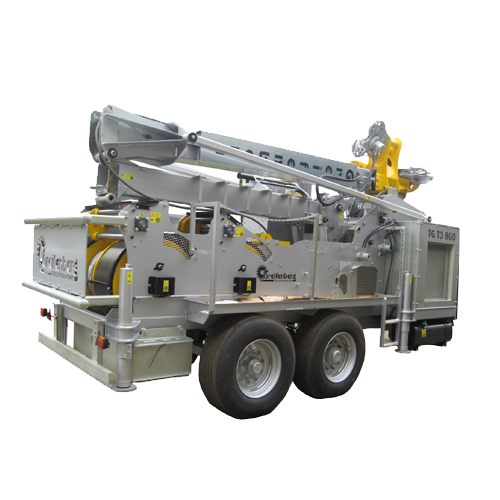
Load capacity 6000 kg, Radio-controlled
The T3 860 Andes is the cableway with the three-rope system for ring work, designed for lines up to 860 meters in length, allowing for logging operations from both uphill and downhill. The fixed-type frame can be installed on a tracked vehicle or a double-axle trailer. Its new design ensures a low centre of gravity, promoting easy access for routine checks and maintenance. The heavy-duty high-strength steel tower can be further extended with a hydraulic extension, and the head unit features flag pulleys and is equipped with a hydraulic expulsion system to ensure correct tensioning of the hauling rope and facilitate its release. On the carrying, hauling, and recovery drums, the hydraulic rope guide ensures proper storage of the ropes. The solid and robust frame, combined with the excellent performance of the six-cylinder Caterpillar diesel engine, the high-quality Linde hydraulic circuit, the epicyclic gearbox transmission, and the management software, are the main features of the power and reliability of the TG 860 Andes, ensuring a longer lifespan.
The machine is controlled via a digital panel with a joystick placed near the cableway, providing constant information to the operator regarding the engine status, the number of revolutions, instantaneous fuel consumption, the delivered torque, engine oil pressure and temperature, and coolant temperature. Additionally, it is possible to choose, set, and adjust the functions of "Greifenberg Technology," such as the radio system, the hauling expulsion system, automatic cycle, alarm backup, smart yarder, and Eco Power system.
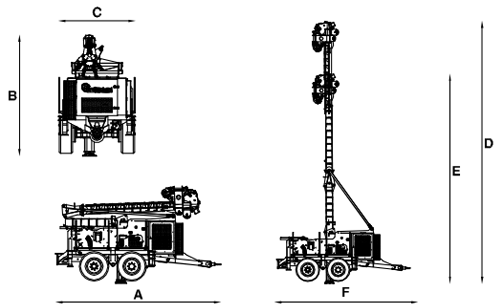
Towed Version
A 6.900 mm
B 3.700 mm
C 2.330 mm
D 13.100 mm
E 10.800 mm
F 6.900 mm
Indicative weight with cables
14 ton
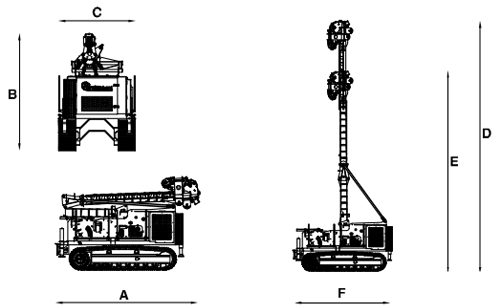
Title description
Tracked Version
A 5.500 mm
B 3.100 mm
C 2.400 mm
D 13.100 mm
E 10.800 mm
F 4.800 mm
Indicative weight with cables
16 ton
| TECHNICAL DATA | |
|---|---|
| Frame mounted on | Trailer / Tracked vehicle / Lorry |
| Diesel engine power | 225 kw - 306 cv |
| Hydraulic system | Dual Linde pump with a closed circuit |
| Control management | Electronics |
| Bracings | no. 4 x 80 m Ø 18 mm |
| CARRIER ROLLER | |
| Rope capacity | 860 m |
| Rope diameter | 22 mm |
| Pulling force first layer | 14000 daN |
| Maximum speed | 0,9 m/sec |
| TOWING ROLLER - RECOVERY | |
| Rope capacity | 860 m - 1800 m |
| Rope diameter | 12 mm |
Radio System

The radio controllers adopted by Greifenberg are the result of years of field experience regarding operating capacity and user ergonomics. They are easily usable even with safety gloves and have an extremely robust "case" capable of withstanding drops and violent impacts. With a comfortable shoulder strap, they can be held with one hand, and thanks to buttons marked with specific icons, manoeuvres during use are extremely simple. A powerful battery ensures operation for an entire working day, and the standard supply also includes a spare battery and a charger. The brain of the radio system is located in the key inserted in the remote control, where communication codes and protocols are stored.
From the radio control, it is possible to perform all the manoeuvres normally carried out from the machine's touchscreen panel. Specifically, it is possible to turn the diesel engine on and off, increase or decrease the rope speed, set and update the end line or loading point, make movements outside the set parameters via the dedicated "bypass" button, start the automatic work cycle to make the machine operate autonomously, control traditional trolleys by opening and closing the locks on the ropes, and perform all the manoeuvres on motorised trolleys by controlling both the motor and the lifting and lowering speed.
Through the radio control, it is possible to set the maximum lifting point of the trolley to ensure that the hook is not mistakenly lifted too high, as well as the maximum unwinding of the rope to prevent the entire rope from unwinding from the trolley drum. If the rope is shortened, it is possible to reset the maximum lifting point to match the new rope length. The same radio control can also integrate the management of Fortronics electronic chokers with an anti-accidental opening system.
The Radio System includes a perfectly coded and integrated radio frequency repeater. The radio controls can operate with one or more repeaters, allowing the working distance to be practically infinite and, above all, capable of overcoming bumps, buildings, and obstacles of any kind, extending the operating distances. The repeater is housed in a robust, small-sized casing, and inside it, a powerful rechargeable battery ensures work even during an intense working day. The repeater should be placed on the summits of bumps or alongside structures to ensure good connectivity both with the transmitter and the receiver. Activation is very simple and is performed with a single button, and the distance is reset with a click.
Greifenberg understands external working conditions with temperatures ranging from sub-zero to scorching sun, snow, water, and humidity. The Radio System is weatherproof: IP65 rating, selected components, contacts treated with anti-oxidation materials; these are the guarantees of a product designed for heavy-duty use. Maximum reliability ensures precise, punctual, and undeniable commands. Transmitters, repeaters, and receivers are ready for non-stop operation.
Ejector

The pulling drum expeller is designed to maintain tension on the rope on the drum in such a way that it prevents slack, which would otherwise compromise proper winding and the rope's lifespan. This means that the pulling rope is redirected onto a motorised pulley, which ensures that the correct tension is maintained between the drum and the pulley, safeguarding the integrity of the steel cable. The pulling rope continuously covers thousands of kilometres between the "wind" and "unwind" functions; for this reason, the pulley is made from special steels, treated thermally, and the hydraulic motor applied is suitable for intensive work.
The pulling force on the rope is adjustable to ensure sufficient extraction force and reduced fuel consumption. A traditional extraction pulley on a cableway can absorb up to 10 to 15 horsepower, impacting fuel consumption by up to 8% of the machine's daily usage. Adjusting the counteracting force and hydraulic pressure allows these values to be halved, reducing consumption and harmful emissions. In cases where the work is carried out on steep inclines or medium-length routes, it is possible, via a command on the control panel, to deactivate the pulling expeller system and use the pulley as a simple free-running pulley with minimal friction.
This system can operate at speeds of up to 10 metres per second for the pulling rope, so even in very long and flat stretches where the sag of the pulling rope becomes highly pronounced, there are no issues with the drum, even at high speeds, ensuring maximum preload on the pulling rope.
Automatic Cycle

ATG, Automatic Travel Greifenberg, is the electronic control and management system, a true form of artificial intelligence, meaning the machine's ability to carry out rope journeys completely autonomously and in automatic cycle. The ATG system takes into account various critical points, such as supports, possible entanglements of the load, excessive power demand on inclines, overspeed during descents, deceleration and acceleration speeds, and the updating of the load point if necessary. It constantly coordinates the work with responsiveness, precision, and accuracy.
To activate the ATG, it is necessary to have the machine recognise the two end points of the line, which are stored as "start of line" and "end of line" through an intuitive procedure on the control panel. Subsequently, it will be possible to store points along the line where the supports are located, which will be interpreted as sensitive points. To ensure smooth translation, the electronic system allows setting the distance from the support at which we want to slow down and the distance after passing the support at which we want to accelerate again and return to normal speed. The distances and the amount of deceleration can be set differently depending on which part of the journey is being made and, consequently, how the entry onto the supports occurs. Indeed, when heavy loads are being transported downhill, it is necessary to gradually slow down at a suitable distance, whereas, after passing the support, speed is quickly regained to avoid rope and load oscillations. On the other hand, if the transport is going uphill, it is sufficient to slow down close to the support as the weight and gravity will already contribute to the deceleration.
Everything is under control during the journey, as the machine, thanks to its pressure transducers and position encoders, constantly monitors the effort, and if it registers abnormal peaks (caused by jams or contrasts), it deactivates the automatic system and halts the journey while always keeping the manual mode available. The ATG function also allows updating the loading or unloading point via the radio control. When the transport needs to frequently change the arrival point to collect or deposit material in different locations, the operator can directly activate the "store new end point" function on the remote control, and the machine will stop at the exact location determined.
Smart Yarder

Information is everything. The "Smart Yarder" function, in addition to keeping you informed about everything your machine is doing, allows you to interact remotely from your smartphone, tablet, or PC. Smart Yarder replicates in real-time everything that the Greifenberg infotainment system communicates via the machine's touch screen panel. Every single piece of information is transmitted and faithfully replicated on your device, but that’s not all—it's also possible to write or modify settings and work programmes. It's a "mirroring" system that duplicates the control point without needing to access the machine. This feature was specifically introduced to make adjustments to work parameters easier and to monitor the machine's status, such as the engine’s RPM, fuel level, or AdBlue level. Access to this function is protected by a password to prevent external access. You just need to activate the Wi-Fi function on your portable device and enter the secret code.
Thanks to a powerful router with an emitting antenna, the machine stays constantly connected within a radius of about 50 meters. This function is particularly appreciated by those operating Greifenberg equipment alongside another vehicle, such as a tractor, skidder, harvester, or excavator. No more climbing up and down from your vehicle! Online controls, checks, and parameter adjustments allow you to remain at your command station, increasing both comfort and productivity.
Touch Screen Display

This type of display is at the top of performance in terms of technology and reliability. It is resistant to weather conditions such as rain and snow. It offers high brightness to ensure excellent visibility, even when exposed to direct sunlight, and provides excellent definition with realistic colours that facilitate reading, even at very oblique viewing angles. The touch screen is patented to be used even while wearing gloves; moreover, all work menus can also be accessed with physical buttons to change the display screen. Every process is under control.
It allows the visualisation of data and the setting of machine parameters with maximum usability flexibility. From the control display, it is possible to select the engine power, view fuel and AdBlue levels, hydraulic system pressure, speed and position of the carriage, position and speed of each drum, check the status of the brakes, determine which drum is active, view alarms, check the machine's maintenance status, and much more. The line parameterisation can either be entered with factory settings or customised in every detail. For example, the deceleration when passing over shoes can be specified according to the direction of entry, whether uphill or downhill, and programmed both in terms of distance and percentage of deceleration. Infinite possibilities for use, intuitive, fast, and adaptable to different situations to tackle any daily task.
Safety Device

The cable cars, in the electronic safety management system, have the function of forced and preset slackening of the carrying cable. This function allows the operator, by pressing a button labelled "carrying cable lowering", to activate an autonomous system for converting hydraulic flows, accelerating the engine, and moderately activating the hydraulic pumps. This mode prevents any possibility of the carriage colliding with the end of the line. The carrying cable lowers until the load being transported makes contact with the ground, stopping any uncontrolled movement. The operator who activates the function, after pressing the button, can move away and ensure their safety. The machine will autonomously carry out the manoeuvre.
Eco Power
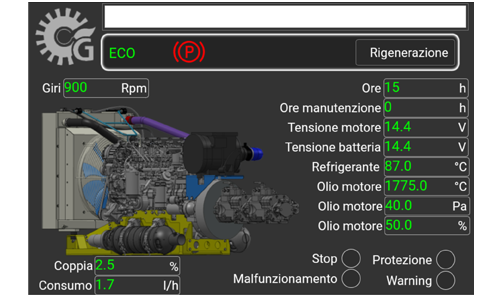
Power only when needed. Greifenberg machines are equipped with powerful engines to ensure they never stop and to perform transports while reducing time and increasing daily productivity. Over-dimensioned engines with high torque, even at low RPM, allow for both high power delivery and sufficient torque for hydrostatic systems at low speeds. The Eco Power system is a control system for engine power output, RPM, and pump flow rate mapping. The selection of the three available modes, Eco Power, Normal Power, and Full Power, adapts the engine and hydrostatic transmission characteristics to meet the needs of your worksite.
If the loads are light and full power is not required, the "Eco Power" mode is selected. This setting, in addition to being eco-friendly by reducing both noise and exhaust gas emissions, allows for fuel savings of up to 40%, thus reducing costs and increasing profitability. The "Normal Power" setting partially limits the diesel power and optimises the pump flow rates, allowing for excellent translation speeds and strong acceleration during fully-loaded starting phases. Fuel consumption and emissions are limited, while work speed is increased. This is a commonly used compromise when transportation needs align with the machine's average performance.
"Full Power" delivers maximum performance. All the power of the diesel engine is available, with the highest performance from the hydrostatic system, and the electronics demand the maximum from the transmission in both speed and torque. In this operating mode, the machine offers top performance, with enhanced acceleration and increased translation speeds. All available power is at your command, without limits.
Backup Alarm

Total control, verification, and statistics. Every alarm, abnormal use, and operation outside the set parameters are automatically recorded and stored in a dedicated memory. Data such as engine overspeed, overpressures, overspeed, oil and water temperature alarms, etc., are immediately recorded. It will be easy for the owner to monitor how the machine is being used, both by their own employees and in the case of renting to third parties. Even for interventions by the technical service, everything becomes faster, reducing management costs. Information dedicated to longevity and maintenance.
Remote Assistance

Our technicians are with you, whenever you want, on your site to help you solve problems. Through remote assistance, simply activate a GPRS connection and allow access to your equipment. This always and exclusively happens with the operator’s authorisation on the machine. Once connected, our electronic and hydraulic technicians can work on the machine as if they were on-site. Maximum intervention speed and reduced costs and waiting times. The innovation of safety always by your side.
Syncro System

This technology is a sophisticated software that manages the perfect synchronisation of the cables in systems with a loop operation. Syncro System controls the tension of the cables and continuously adjusts the speed of the drums in an automated manner. The parameters of cable speed, hydrostatic transmission pressure, rotational speed of the drums, and engine RPM are continuously analysed and compared at a speed of 10 milliseconds. The electronics manage a multitude of input variables to generate a signal for the control of the hydraulic transmissions. Everything occurs autonomously and automatically, and the operator can control the machine either in manual mode or in "automatic cycle" mode, with every action always under control. Absolute simplicity, smooth variations without jolts, no more slack cables, and smooth starts and stops – this is the Greifenberg Syncro System.
3 Mediterranea is a cableway with the trifune system for loop work, used for lines up to 550 metres in length, allowing for logging work both from the mountain and from the valley. The strong point of this machine is its extreme robustness, which ensures reliability and safety. All components of this machine have been designed with over-dimensioned specifications, thus guaranteeing less wear over time and greater durability. It is a machine that is typically mounted on a single-axle trailer, but it can also be installed on a double axle with a tandem system or on a tracked vehicle. The fixed-type frame helps maintain a low centre of gravity, making its movement safer. The two-section tower is equipped with a head featuring flag-style pulleys.
The T3 Mediterranea features polyester guy ropes with ratchet pre-tensioning, which are very easy to install, and, thanks to the rubber sleeve at the end, they protect the tree trunk to which they are anchored. The hydraulic system, by Linde, is powered by a 4-cylinder Stage V diesel engine. The electronic management system allows for the self-diagnosis of the diesel engine, hydraulic system, and electrical system. Additionally, it is possible to select between three different engine mapping options, determining the "character" of the machine, which results in smoother movements to reduce fuel consumption or more aggressive actions that optimise performance. This machine allows for the parameterisation of loading, unloading points, and intermediate slowdowns, which the machine will recognise and manage automatically.
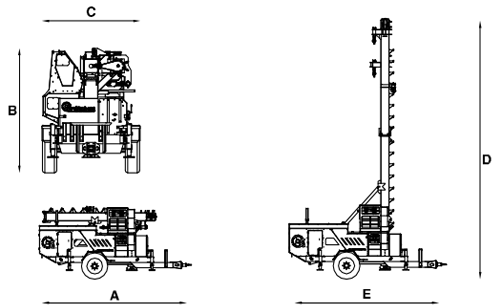
Towed Version
A 5.700 mm
B 2.700 mm
C 2.150 mm
D 9.300 mm
E 5.700 mm
Indicative weight with cables
8 ton

Title description
Tracked Version
A 4.600 mm
B 2.600 mm
C 2.300 mm
D 9.300 mm
E 4.500 mm
Indicative weight with cables
10 ton
| TECHNICAL DATA | |
|---|---|
| Frame mounted on | Rimorchio / cingolato / autocarro |
| Diesel engine power | 75 kw - 101 cv |
| Hydraulic system | Dual Linde pump with a closed circuit |
| Control management | Electronics |
| Bracings | no. 6 x 40 m textile |
| CARRIER ROLLER | |
| Rope capacity | 490 m |
| Rope diameter | 20 mm |
| Pulling force first layer | 10400 daN |
| Maximum speed | 1,5 m/sec |
| TOWING ROLLER - RECOVERY | |
| Rope capacity | 470 m - 1000 m |
| Rope diameter | 10 mm |
Radio System

The radio remote controls adopted by Greifenberg are the result of years of field experience in terms of operating range and ease of use. They are comfortably usable with safety gloves and feature an extremely robust “case” capable of withstanding drops and violent impacts. With a convenient shoulder strap, they can be held with one hand, and thanks to buttons marked with specific icons, the maneuvers during operation are incredibly simple. A powerful battery ensures a full workday’s operation, and the standard supply also includes a spare battery and a charger.
The brain of the radio system is located in the key inserted into the remote control, where communication codes and protocols are stored.
From the remote control, it is possible to perform all the maneuvers typically executed from the machine's touch screen. In fact, you can turn the diesel engine on and off, increase and decrease the speed of the ropes, set and update the end-of-line or load point, make movements outside the set parameters using the dedicated “bypass” button, start the automatic working cycle to let the machine operate autonomously, control traditional carriages by opening and closing the blocks on the ropes, and perform all maneuvers on the motorized carriages, controlling both the motor and the lifting and lowering speed.
Through the remote control, it is also possible to set the maximum lifting point of the carriage to prevent the hook from being raised too much, as well as the maximum unwinding of the rope, avoiding unrolling the entire rope wound on the carriage drum. If the rope is shortened, it is possible to reset the maximum lifting point, updating it to the new rope length.
The same remote control can also integrate the management of Fortronics electronic chokers with an anti-accidental opening system.
The Radio System includes a perfectly coded and integrated radio frequency repeater. The remote controls can operate with one or more repeaters, making the working distance virtually infinite, even allowing it to overcome bumps, buildings, and obstacles of any kind, thereby extending the operational distances. The repeater is housed in a small, durable casing, and inside, a powerful rechargeable battery ensures operation even during an intense workday. The repeater should be placed on the peaks of bumps or beside structures so that it has a strong connection both to the transmitter and the receiver. Activation is straightforward, performed with a single button, and the distance is reset with one click.
Greifenberg understands the external working conditions with temperatures ranging from below freezing to scorching heat, snow, water, and humidity. The Radio System is resistant to the elements: with an IP65 rating, selected components, and contacts treated with anti-corrosive materials, these are the guarantees of a product designed for tough working conditions. Maximum reliability ensures precise, punctual, and indisputable controls. Transmitters, repeaters, and receivers are ready for non-stop work.
Ejector

The traction rope ejector is able to maintain the tension of the rope on the drum in such a way that it prevents any slack that could compromise the correct winding and the rope's durability. This means that the traction rope is redirected onto a motorised pulley, which ensures that there is always the correct tension between the roller and the pulley, safeguarding the integrity of the steel cable. The traction rope continuously travels thousands of kilometres between the "wind" and "unwind" functions. For this reason, the pulley is made from special steels and thermally treated, while the hydraulic motor applied is suitable for intensive work.
The traction force on the rope is adjustable to ensure sufficient extraction force while reducing fuel consumption. A traditional extraction pulley on a cableway can consume up to 10/15 horsepower, impacting fuel consumption by as much as 8% of the machine's daily fuel usage. Adjusting the counterforce and hydraulic pressure settings allows these values to be halved, reducing fuel consumption and harmful emissions.
In cases where the work is carried out on steep slopes and medium-length tracks, it is possible, via a control on the panel, to deactivate the traction ejector system and use the pulley as a simple freewheel pulley with minimal friction.
This system can work at speeds of up to 10 metres per second for the traction rope. Therefore, even in the case of very long and flat stretches where the catenary of the traction rope becomes very pronounced, there is no problem with the roller, even at high speeds, ensuring maximum preload on the traction rope.
Automatic Cycle

ATG, Automatic Travel Greifenberg, is the electronic control and management system, a true artificial intelligence, meaning the machine’s ability to travel along the rope fully autonomously and in automatic cycle. The ATG system takes into account various critical points, such as the supports, potential entanglements of the load, excessive power demand on uphill sections, overspeed during descents, deceleration and acceleration speeds, and, if necessary, updating the loading point. It continuously coordinates the work with responsiveness, precision, and accuracy.
To activate the ATG, the machine must recognise the two extreme points of the line, which are stored as “start of line” and “end of line” through an intuitive procedure on the control panel. Subsequently, it will be possible to store the points along the line where the supports are located, which will be interpreted as sensitive points. To ensure smooth translation, the electronic system allows you to set the distance from the support at which we want to slow down and the distance at which, after passing it, we want to accelerate again and return to the normal speed. The distances and the amount of deceleration can be entered differently depending on which part of the journey we are undertaking and, consequently, how we approach the supports.
For example, when carrying heavy loads downhill, it is necessary to slow down gradually from a proper distance, and once the support is passed, speed is quickly resumed to avoid rope and load oscillations. On the other hand, if the transport is going uphill, it is sufficient to slow down close to the support, as the weight and gravity already assist with deceleration.
Everything is under control during the journey; the machine, thanks to its pressure transducers and position encoders, constantly monitors the effort and, if it detects any abnormal spikes (caused by jams or resistance), it deactivates the automatic system, halting the journey while still allowing for manual operation. The ATG function also allows for the updating of the loading or unloading point via the radio control. When the transport needs to frequently change its destination to pick up or deposit material in different locations, simply activate the "store new end point" function from the remote control, and the machine will stop exactly at the specified location.
Colour Display

The colour display for machine data and line data offers greater accessibility, enhanced intuitiveness at first glance, ease of line parameterisation, and a simplified procedure for synchronising the remote controls of the trolleys. The new series of displays allows for quick checks, constantly informing the operator about position, efforts, shoe positions, engine revolutions, fuel consumption, and fuel levels. The most relevant data are displayed both in analogue and digital formats to increase the immediacy of reading.
Safety Device

The cableways, in the electronic safety management system, have the function of forced and preset loosening of the supporting cable. This function allows the operator, by pressing a button called "support lowering", to activate an autonomous system that converts hydraulic flows, accelerates the engine, and moderately activates the hydraulic pumps. Any possibility of the trolley colliding with the end of the line is prevented by this mode. The supporting cable lowers until it brings the load in contact with the ground, stopping any uncontrolled movement. Once the operator has pressed the button to activate the function, they can move away and position themselves in safety. Your machine will autonomously carry out the manoeuvre.
Backup Alarm

Total control, verification, and statistics.
Every alarm, abnormal use, and operation outside the parameters are automatically recorded and stored in a dedicated memory. Data such as engine over-revving, over-pressures, over-speed, oil and water temperature alarms, etc., are immediately logged. It will be easy for the owner to check how the machine is being used, both by their employees and in the case of rentals to third parties. Even for service interventions, everything becomes quicker, reducing management costs. Information is available to assist with the machine's durability and maintenance.
Remote Assistance

Our technicians with you, whenever you want, on your site to help you solve problems.
Through remote assistance, simply activate a GPRS connection and allow the connection to your equipment. This always happens exclusively with the operator's authorisation for the machine. Once connected, our electronic and hydraulic technicians can work on the machine as if they were there on site. Maximum speed of intervention and reduction of costs and waiting times. The innovation of safety always by your side.
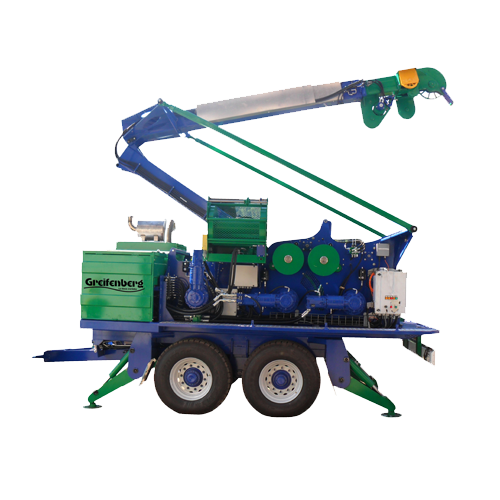
Load capacity 6000 kg, Radio-controlled
T3 1000 Nevada is pure power with a technological heart. The trifune cableway is capable of creating lines up to 1000 metres in length, either by gravity or loop, with incredible pulling force, without the need for external equipment, and with the possibility of having stations both uphill and downhill. The frame, with a rotating turntable and hydraulic mechanism, can be installed on a tracked vehicle or a double-axle trailer, allowing for quick and effective positioning in any type of terrain. The powerful, high-strength steel folding tower can accommodate an additional hydraulic extension to increase the height. The pulleys are arranged on the tower with a hinged system, ensuring the exact direction is always achieved.
The T3 1000 Nevada enables the creation of impressive lines, combined with excellent manoeuvrability, aided by the installation roller for laying the carrying rope. Thanks to the state-of-the-art touchscreen panel and the 10-metre extension, the operator can position themselves at the point with the best visibility to remotely set all line parameters, such as loading point, unloading point, and intermediate slowdown supports. Control and parameterisation of functions are carried out via a digital panel located on the machine, with all services, such as cylinders for lifting the tower, lowering the strut, and stabilisers, being controlled via the touchscreen panel.
Machine operation is remotely controlled via two radio controls equipped with multi-step technology, allowing the operator to always select the most suitable working speed. The radio controls can also be used to operate the Greifenberg trolleys and chockers if present. The ATG electronic system automates the machine to the level of autonomous driving. In a simple process, it is possible to store the cableway line by setting the starting point, the endpoint, and up to four support shoes. After entering this simple data, the cableway will be able to perform translations on its own without the operator being present.

Towed Version
A 6.670 mm
B 3.600 mm
C 2.320 mm
D 12.800 mm
E 10.300 mm
F 6.250 mm
Indicative weight with cables
18 ton
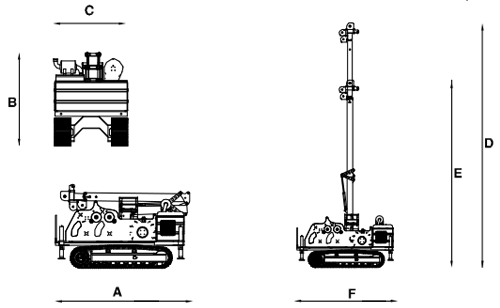
Titolo descrizione
Tracked Version
A 7.000 mm
B 3.100 mm
C 2.400 mm
D 17.000 mm
E 13.000 mm
F 4.800 mm
Indicative weight with cables
20 ton
| TECHNICAL DATA | |
|---|---|
| Frame mounted on | Trailer / Tracked vehicle / Lorry |
| Diesel engine power | 300 kw - 408 cv |
| Hydraulic system | Dual Linde pump with a closed circuit |
| Control management | Electronics |
| Bracings | no. 4 x 80 m Ø 18 mm |
| CARRIER ROLLER | |
| Rope capacity | 1100 m |
| Rope diameter | 24 mm |
| Pulling force first layer | 16000 daN |
| Maximum speed | 0,9 m/sec |
| PULLING DRUM | |
| Rope capacity | 1100 m - 2200 m |
| Rope diameter | 12 mm |
Radio System

The radio controls adopted by Greifenberg are the result of years of field experience regarding operating capacity and user ergonomics. They are easily used with safety gloves and feature an extremely robust "case" capable of withstanding drops and violent impacts. With a convenient shoulder strap, they can be held with one hand, and, thanks to buttons marked with specific icons, manoeuvres during use are very simple. A powerful battery ensures the system lasts for an entire working day. Additionally, the standard supply also includes a spare battery and a charger. The brain of the radio system is located in the key inserted into the remote control, where codes and communication protocols are stored.
From the remote control, it is possible to carry out all the manoeuvres that are typically performed from the machine's touchscreen panel. For instance, you can start and stop the diesel engine, increase and decrease the rope speeds, set and update the end-of-line or loading point, perform movements outside the set parameters using the dedicated "bypass" button, start the automatic work cycle, making the machine operate autonomously, control traditional trolleys by opening and closing the rope locks, and even perform all manoeuvres on motorised trolleys, controlling both the motor and the lifting and lowering speed.
Through the remote control, you can set the maximum lifting point of the trolley to prevent the hook from being accidentally lifted too high, as well as the maximum unwinding of the rope, preventing the entire rope on the trolley drum from being unwound. If the rope is shortened, it is possible to reset the maximum lifting point to the new rope length. The same remote control can also integrate the management of Fortronics electronic chockers with an accidental opening prevention system.
The Radio System includes a frequency repeater that is perfectly coded and integrated. The remote controls can operate with one or more repeaters, making the working distance virtually limitless, and most importantly, capable of overcoming bumps, buildings, and any other kind of obstacle, thereby extending operational distances. The repeater is contained in a robust, compact casing, and inside, a powerful rechargeable battery ensures it can work through a full working day. The repeater should be placed on the peaks of bumps or beside structures to ensure good connectivity both to the transmitter and the receiver. The activation is very simple, performed via a single button, and the distance is reset with one click.
Greifenberg understands the external working conditions, with temperatures ranging from below zero to scorching sun, snow, water, and humidity. The Radio System is not affected by the elements: IP65 class, selected components, and contacts treated with anti-oxidant materials; these are the guarantees of a product designed for tough environments. Maximum reliability ensures precise, timely, and indisputable controls. Transmitters, repeaters, and receivers are ready for work without interruption.
Ejector

The traction rope expeller is designed to keep the rope taut on the drum, ensuring there are no slack areas that could compromise its proper winding and overall durability. This means that the traction rope is redirected onto a motorised pulley, which ensures that the correct tension is maintained between the drum and the pulley, safeguarding the integrity of the steel cable. The traction rope continuously covers thousands of kilometres between the "wind" and "unwind" functions. For this reason, the pulley is made of special steels and treated thermally, and the hydraulic motor applied is suitable for intensive work.
The traction force on the rope is adjustable to guarantee sufficient extraction power and lower fuel consumption. A traditional extraction pulley on a cableway can absorb up to 10-15 HP, affecting fuel consumption by up to 8% of the machine's daily fuel usage. Adjusting the counteracting force and hydraulic pressure allows these values to be halved, reducing both consumption and harmful emissions.
For cases where the work is carried out on steep slopes and medium-length tracks, it is possible, via a control on the panel, to disengage the traction expeller system and use the pulley as a simple free pulley, reducing excessive friction.
This system can work at speeds of up to 10 metres per second for the traction rope, so even in the case of very long and flat sections where the catenary of the traction rope becomes very pronounced, there is no issue with the drum, even at high speeds, guaranteeing maximum preload on the traction rope.
Automatic Cycle

TG (Automatic Travel Greifenberg) is the electronic control and management system, a true artificial intelligence, meaning the machine’s ability to travel along the rope completely autonomously and in automatic cycle. The ATG system takes into account various critical points such as the supports, potential load entanglements, excessive power demand when climbing, overspeed during descents, deceleration and acceleration speeds, and updating the loading point if necessary. It constantly coordinates the work with responsiveness, precision, and accuracy.
To activate the ATG, it is necessary for the machine to recognise the two extreme points of the line, which are then stored as the “start of the line” and the “end of the line” using an intuitive procedure on the control panel. It will then be possible to store the points along the line where the supports are located, which will be interpreted as sensitive points. To achieve linearity in translation, the electronic system allows you to set the distance from the support where you want to decelerate and the distance after passing the support where you want to accelerate again and return to normal speed. The distances and the amount of deceleration can be entered differently depending on the direction of travel and the approach to the supports. In fact, when transporting heavy loads downhill, it is necessary to gradually slow down at an appropriate distance, and once the support is passed, the speed is quickly regained to avoid rope and load oscillations. Conversely, if the transport is uphill, it is sufficient to slow down near the support, as the weight and gravity already assist in deceleration.
Everything is under control during the journey. In fact, the machine, thanks to its pressure transducers and position encoders, constantly monitors the effort and, if it detects abnormal peaks (caused by blockages or resistances), it deactivates the automatic system, halting the journey but always keeping the manual mode available. The ATG function also allows for the updating, via the radio control, of the loading or unloading point. When the transport needs to change the destination point frequently to pick up or deposit materials in different places, simply activate the "store new end point" function directly from the remote control, and the machine will stop its journey exactly at the designated location.
Smart Yarder

Information is everything. The “Smart Yarder” function, in addition to keeping you informed about everything your machine is doing, allows you to interact remotely via your smartphone, tablet, or PC. Smart Yarder accurately replicates everything the Greifenberg infotainment system communicates through the machine’s touch screen panel. Every single piece of information is transmitted and faithfully replicated on your device. But that's not all — it’s possible to write or modify settings and work programmes. This “mirroring” system duplicates the control point without the need to access the machine directly. This innovation was introduced primarily to facilitate the adjustment of work parameters and to monitor the machine's status, such as engine RPM, fuel level, or AdBlue level. Access to this function is secured by a password to prevent unauthorised access. Simply activate the Wi-Fi function on your portable device and enter the secret code.
Thanks to a powerful router with a transmitting antenna, the machine remains constantly connected within a range of approximately 50 metres. This function is particularly appreciated by those operating both the Greifenberg equipment and other machines such as tractors, skidders, harvesters, or excavators. No more getting on and off your vehicle! Online controls, checks, and parameter adjustments allow you to stay in your command position, increasing comfort and productivity.
Touch Screen Display

This type of display is at the top of performance in terms of technology and reliability. It is resistant to weather conditions such as rain and snow. It offers high brightness to ensure excellent visibility even when exposed to sunlight, with outstanding definition and realistic colours that facilitate readability even at very oblique viewing angles. The touch screen is patented to be used even with gloves. Additionally, all work menus can be accessed via physical buttons to change the screen view. Every process is under control. It allows the visualisation of data and the setting of machine parameters with maximum flexibility. From the control display, it is possible to select the engine power, view fuel and AdBlue levels, hydraulic system pressure, the speed and position of the carriage, the position and speed of each roller, check the brake status, identify which roller is active, view alarms, check the machine’s maintenance status, and much more. The line parameterisation can be entered with factory data or customised in every detail. For example, the deceleration during the crossing of the shoes can be detailed according to the direction of entry, whether uphill or downhill, and programmed both in terms of distance and deceleration percentage. Infinite possibilities of use, intuitive, fast, and adaptable to different situations to tackle every type of daily activity.
Safety Device

The cable cars, in the electronic safety management system, have the function of forced and preset slackening of the carrying cable. This function allows the operator, by pressing a button labelled "carrying cable lowering", to activate an autonomous system for converting hydraulic flows, accelerating the engine, and moderately activating the hydraulic pumps. This mode prevents any possibility of the carriage colliding with the end of the line. The carrying cable lowers until the load being transported makes contact with the ground, stopping any uncontrolled movement. The operator who activates the function, after pressing the button, can move away and ensure their safety. The machine will autonomously carry out the manoeuvre.
Eco Power

Power only when needed. Greifenberg machines are equipped with powerful engines that never stop, allowing for faster transport and increased daily productivity. Over-dimensioned engines with high torque at low RPM enable both high power output and sufficient torque for low-speed hydrostatic systems. The Eco Power system controls the engine's power output, RPM, and the pump flow rate mapping. The selection of the three available modes, Eco Power, Normal Power, and Full Power, adapts the engine and hydrostatic transmission characteristics to the specific needs of your worksite.
If the loads are light and full power is not required, the “Eco Power” mode is selected. This setting, in addition to being “eco-friendly” by reducing both noise and exhaust emissions, allows for fuel savings of up to 40%, thus lowering costs and increasing profitability. The “Normal Power” setting partially limits the diesel engine power and optimises the pump flow rates, providing excellent travel speeds and good acceleration during full load start-up. Fuel consumption and emissions are reduced, while work speed increases. This is a commonly used compromise when transport requirements match the machine's average performance.
“Full Power” delivers maximum performance. All available diesel horsepower, maximum hydrostatic system performance — the electronics demand the utmost from the transmission in both speed and torque. In this operating mode, the machine offers top performance, with enhanced power bursts and increased travel speed. All the available power at your fingertips, with no limits.
Backup Alarm

Total control, verification, and statistics. Every alarm, abnormal use, and operation outside the set parameters are automatically recorded and stored in a dedicated memory. Data such as engine overspeed, overpressures, overspeed, oil and water temperature alarms, etc., are immediately recorded. It will be easy for the owner to monitor how the machine is being used, both by their own employees and in the case of renting to third parties. Even for interventions by the technical service, everything becomes faster, reducing management costs. Information dedicated to longevity and maintenance.
Remote Assistance

Our technicians are with you, whenever you want, on your site to help you solve problems. Through remote assistance, simply activate a GPRS connection and allow access to your equipment. This always and exclusively happens with the operator’s authorisation on the machine. Once connected, our electronic and hydraulic technicians can work on the machine as if they were on-site. Maximum intervention speed and reduced costs and waiting times. The innovation of safety always by your side.
Syncro System

This technology is a sophisticated software that manages the perfect synchronisation of the cables in systems with a loop operation. Syncro System controls the tension of the cables and continuously adjusts the speed of the drums in an automated manner. The parameters of cable speed, hydrostatic transmission pressure, rotational speed of the drums, and engine RPM are continuously analysed and compared at a speed of 10 milliseconds. The electronics manage a multitude of input variables to generate a signal for the control of the hydraulic transmissions. Everything occurs autonomously and automatically, and the operator can control the machine either in manual mode or in "automatic cycle" mode, with every action always under control. Absolute simplicity, smooth variations without jolts, no more slack cables, and smooth starts and stops – this is the Greifenberg Syncro System.
Mediterranea is a simple and quick-to-use cableway, economical and ideal for those approaching the forestry world. Built on a very robust steel frame, the tower is raised by a hydraulic piston and can be conveniently folded laterally in a manual manner. The head is equipped with a rotating carrying pulley and a flag-type traction pulley. The carrying and traction rollers are arranged longitudinally to allow a wide working angle. A unique feature of Mediterranea is the polyester bracing with ratchet pretensioning, which is very easy to install, and thanks to the rubber sheath at the end, it protects the tree trunk to which they are anchored. The control panel with hydraulic manipulator for the roller movement can be positioned remotely. The cableway also features the engine management panel and the manual lever distributor for services such as: piston for tower lifting, tower strut, directly on board the machine.

Towed Version
A 5.400 mm
B 2.550 mm
C 2.150 mm
D 9.300 mm
E 5.000 mm
Indicative weight with cables
5 ton

Title description
Tracked Version
A 4.600 mm
B 2.600 mm
C 2.300 mm
D 9.300 mm
E 4.500 mm
Indicative weight with cables
10 ton
| TECHNICAL DATA | |
|---|---|
| Frame mounted on | Trailer / Tracked vehicle / Lorry |
| Diesel engine power | 45,5 kw - 62 cv |
| Hydraulic system | Closed circuit |
| Control management | Hydraulics |
| Bracings | no. 4 x 40 m textile |
| CARRIER ROLLER | |
| Rope capacity | 490 m |
| Rope diameter | 20 mm |
| Pulling force first layer | 10400 daN |
| Maximum speed | 1,3 |
| TOWING ROLLER - RECOVERY | |
| Rope capacity | 470 m |
| Rope diameter | 10 mm |
| PULLING DRUM | |
| Rope capacity | 470 m |
| Rope diameter | 10 mm |
Radio System

The remote controls adopted by Greifenberg are the result of years of field experience regarding operational capacity and ergonomics of use. They are comfortably usable with safety gloves and feature an extremely robust “case” that can withstand drops and violent impacts. With a handy shoulder strap, they can be held with one hand, and thanks to the buttons marked with specific icons, manoeuvres during use are extremely simple. A powerful battery ensures a full day of work, and the standard supply also includes a spare battery and a charger. The brain of the radio system is located in the key inserted into the remote control, where codes and communication protocols are stored.
From the remote control, it is possible to perform all the manoeuvres normally carried out via the machine’s touch screen panel. Indeed, you can switch the diesel engine on and off, increase or decrease the speed of the ropes, set and update the end of line or loading point, make movements outside the set parameters via the dedicated “by-pass” button, start the automatic working cycle for autonomous operation, control traditional trolleys by opening and closing the blocks on the ropes, and even carry out all manoeuvres on motorised trolleys, controlling both the motor and the lifting and lowering speed. Through the remote control, it is possible to set the maximum lifting point of the trolley to ensure the hook is not accidentally lifted too high, as well as the maximum unwinding of the rope to prevent unspooling the entire rope wound on the trolley drum. If the rope is shortened, it is possible to reset the maximum lifting point to reflect the new length of the rope.
The same remote control can also integrate the management of Fortronics electronic chokers with an anti-accidental opening system.
The Radio System includes a perfectly coded and integrated frequency repeater. The remote controls can operate with one or more repeaters, extending the working distance infinitely and overcoming hills, buildings, and obstacles of all kinds, thus expanding operational range. The repeater is housed in a robust, compact enclosure, and inside it, a powerful rechargeable battery allows operation throughout a demanding working day. The repeater should be placed at the top of hills or beside structures to ensure a good connection both to the transmitter and the receiver. Activation is very simple, done with a single button press, and the distance is reset with one click.
Greifenberg understands the challenging external working conditions, with temperatures ranging from sub-zero to scorching sun, snow, rain, and humidity. The Radio System is immune to the elements: rated IP65, with selected components and contacts treated with anti-oxidant materials. These are the guarantees of a product designed for heavy-duty work. Maximum reliability ensures precise, punctual, and indisputable commands. Transmitters, repeaters, and receivers are ready for non-stop work.
Ejector

The expeller of the pulling rope is designed to maintain tension on the drum in such a way that no slack is created, which could compromise the correct winding and the durability of the rope itself. This means that the pulling rope is redirected onto a motorised pulley, which ensures that the correct tension is always maintained between the roller and the pulley, protecting the integrity of the steel cable. The pulling rope continuously travels thousands of kilometres between the “wind” and “unwind” functions, so the pulley is made from special steels and is thermally treated, while the hydraulic motor applied is suitable for intensive work.
The traction force on the rope is adjustable to ensure sufficient pulling power while reducing fuel consumption. A traditional extraction pulley on a cableway can absorb up to 10-15 horsepower, affecting fuel consumption by up to 8% of the machine's daily fuel use. Adjusting the counter-force and hydraulic pressure allows these values to be halved, reducing fuel consumption and harmful emissions. In cases where the work takes place on steep slopes and medium-length tracks, it is possible, via a command on the control panel, to disengage the pulling expeller system and use the pulley as a simple idler pulley without excessive friction.
This system can operate at speeds of up to 10 metres per second for the pulling rope, so even in very long and flat stretches where the catenary of the pulling rope becomes very accentuated, there are no issues with the roller, even at high speeds, ensuring maximum pre-tension on the pulling rope.
Automatic Cycle

ATG, Automatic Travel Greifenberg, is the electronic control and management system, a true form of artificial intelligence, meaning the machine's ability to travel along the rope autonomously and in automatic cycle. The ATG system takes into account various critical points, such as the supports, potential entanglements of the load, excessive power demand when climbing, over-revving during descents, deceleration and acceleration speeds, and updates the loading point if necessary. It continuously coordinates the work with responsiveness, precision, and accuracy.
To activate the ATG, it is necessary to register the two extreme points of the line, which are stored as "start of line" and "end of line" through an intuitive procedure on the control panel. Subsequently, it will be possible to store the points along the line where the supports are located, which will be interpreted as sensitive points. To achieve a smooth translation, the electronic system allows you to set the distance at which you want to decelerate before the support and the distance at which, after passing the support, you want to accelerate and return to normal speed. The distances and the amount of deceleration can be set differently depending on the direction of travel and, consequently, the entry onto the supports. When transporting heavy loads downhill, it is necessary to gradually decelerate at an adequate distance, while after passing the support, the speed is quickly regained to avoid rope and load oscillations. Conversely, if the transport is taking place uphill, it is sufficient to slow down close to the support, as the weight and gravity already contribute to the deceleration.
Everything is under control during the journey, as the machine, thanks to its pressure transducers and position encoders, constantly monitors the effort. If it registers any abnormal peaks (caused by blockages or resistance), it deactivates the automatic system, stopping the journey, but always keeping the manual mode available. The ATG function also allows you to update, via the radio control, the loading or unloading point. When the transport frequently changes the arrival point to pick up or deposit materials in different locations, simply activate the "store new end point" function directly from the radio control, and the machine will stop its journey exactly at the determined location.
Colour Display

The colour display for machine data and line data offers greater accessibility, enhanced intuitiveness at first glance, ease of line parameterisation, and a simplified procedure for synchronising the remote controls of the trolleys. The new series of displays allows for quick checks, constantly informing the operator about position, efforts, shoe positions, engine revolutions, fuel consumption, and fuel levels. The most relevant data are displayed both in analogue and digital formats to increase the immediacy of reading.
Safety Device

The cableways, in the electronic safety management system, have the function of forced and preset loosening of the supporting cable. This function allows the operator, by pressing a button called "support lowering", to activate an autonomous system that converts hydraulic flows, accelerates the engine, and moderately activates the hydraulic pumps. Any possibility of the trolley colliding with the end of the line is prevented by this mode. The supporting cable lowers until it brings the load in contact with the ground, stopping any uncontrolled movement. Once the operator has pressed the button to activate the function, they can move away and position themselves in safety. Your machine will autonomously carry out the manoeuvre.
Backup Alarm

Total control, verification, and statistics.
Every alarm, abnormal use, and operation outside the parameters are automatically recorded and stored in a dedicated memory. Data such as engine over-revving, over-pressures, over-speed, oil and water temperature alarms, etc., are immediately logged. It will be easy for the owner to check how the machine is being used, both by their employees and in the case of rentals to third parties. Even for service interventions, everything becomes quicker, reducing management costs. Information is available to assist with the machine's durability and maintenance.
Remote Assistance

Our technicians with you, whenever you want, on your site to help you solve problems.
Through remote assistance, simply activate a GPRS connection and allow the connection to your equipment. This always happens exclusively with the operator's authorisation for the machine. Once connected, our electronic and hydraulic technicians can work on the machine as if they were there on site. Maximum speed of intervention and reduction of costs and waiting times. The innovation of safety always by your side.
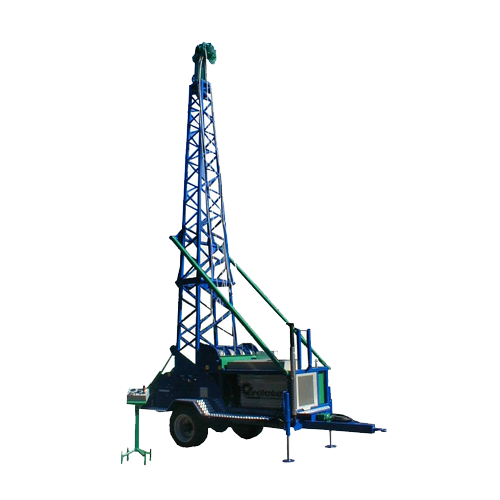
Load capacity 6000 kg, Radio-controlled
The TG 700 WORKER is developed as a machine with characteristics of lightness, manoeuvrability, and high performance, capable of covering a line of 700 metres. The TG 700 presents itself to the specialist operator as a machine of great productivity with low operating costs. The machine's frame is designed to be equipped either with a towing axle or a tracked carriage. The tower, made of high-strength tubular steel and hydraulically foldable, is equipped with a rotating head with rope diversion pulleys and a hydraulic expeller that facilitates the exit of the hauling rope. The motorised bracing, hydraulic stabiliser feet, and the automatic rope guide on the hauling drum speed up the installation process. The digital control panel constantly informs the operator of all machine parameters, also utilising EcoPower Technology. The TG 700 Worker is equipped with an integrated radio control system with a repeater to cover long distances. Line memorisation and automatic cycle operation make the TG 700 the ideal machine for those aiming to industrialise their site.

Towed Version
A 6.650 mm
B 3.100 mm
C 2.050 mm
D 9.500 mm
F 5.500 mm
Indicative weight with cables
7 ton

Title description
Tracked Version
A 5.700 mm
B 3.000 mm
C 2.400 mm
D 9.500 mm
F 3.900 mm
Indicative weight with cables
9 ton
| TECHNICAL DATA | |
|---|---|
| Frame mounted on | Trailer / Tracked vehicle / Lorry |
| Diesel engine power | 74 kw - 101 cv |
| Hydraulic system | Dual Linde pump with a closed circuit |
| Control management | Electronics |
| Bracings | no. 4 x 80 m Ø 16 mm |
| CARRIER ROLLER | |
| Rope capacity | 700 m |
| Rope diameter | 20 mm |
| Pulling force first layer | 10400 daN |
| Maximum speed | 1 m/sec |
| PULLING DRUM | |
| Rope capacity | 700 m |
| Rope diameter | 10 mm |
Radio System

The radio controls adopted by Greifenberg are the result of years of field experience in terms of operating range and usability ergonomics. They are comfortably usable with safety gloves and feature an extremely robust "case" designed to withstand drops and violent impacts. With the convenient shoulder strap, they can be held with one hand, and, thanks to buttons marked with specific icons, the operations during use are extremely simple. A powerful battery ensures operation for an entire working day; additionally, the standard supply also includes a spare battery and a charger. The brain of the radio system is located in the key inserted into the remote control, where communication codes and protocols are stored.
From the remote control, it is possible to perform all the maneuvers typically carried out from the machine’s touch screen panel. In fact, you can turn the diesel engine on and off, increase and decrease the speed of the ropes, set and update the end line or load point, make adjustments outside the set parameters using the dedicated "by-pass" button, start the automatic work cycle to make the machine operate autonomously, control the traditional trolleys by opening and closing the rope locks, and also carry out all the maneuvers on the motorised trolleys, controlling both the motor and the lifting and lowering speed.
Through the remote control, you can set the maximum lifting point of the trolley so that the hook is not incorrectly raised too high, as well as the maximum rope unrolling, preventing the entire rope wound on the drum from being unwound. If the rope is shortened, the maximum lifting point can be re-set, updating it to the new rope length. The same remote control can also integrate the management of the Fortronics electronic chokers with an accidental anti-opening system.
The Radio System includes a perfectly coded and integrated radio frequency repeater. The remote controls can operate with one or more repeaters, allowing for infinite working distance, and, most importantly, capable of overcoming bumps, buildings, and any obstacles, extending the operational range. The repeater is contained in a small, rugged housing, with a powerful rechargeable battery inside, enabling operation even during long working days. The repeater should be placed at the top of bumps or at the side of structures to ensure a good connection both to the transmitter and the receiver. Activation is very simple, performed with a single button, and the distance can be reset with just one click.
Greifenberg understands external working conditions, with temperatures ranging from sub-zero to intense heat, snow, water, and humidity. The Radio System is not affected by the elements: IP65 rated, selected components, contacts treated with anti-corrosive materials; these are the guarantees of a product built for heavy-duty work. Maximum reliability to ensure precise, timely, and undeniable commands. Transmitters, repeaters, and receivers are ready for non-stop operation.
Ejector

The expeller for the hauling rope is able to maintain tension on the rope on the drum in such a way that no slack is created, which could compromise its proper winding and the rope’s lifespan. This means that the hauling rope is redirected onto a motorised pulley, ensuring that there is always the correct tension between the roller and the pulley, thus safeguarding the integrity of the steel cable. The hauling rope travels continuously thousands of kilometres between the "wind" and "unwind" functions, which is why the pulley is made of special steels and heat-treated, and the hydraulic motor applied is suitable for intensive work.
The pulling force on the rope is adjustable to ensure sufficient extraction force and lower fuel consumption. A traditional extraction pulley on a cableway can absorb up to 10-15 horsepower, affecting fuel consumption by up to 8% of the machine's daily fuel usage. Adjusting the counterforce and hydraulic pressure allows these values to be halved, reducing both consumption and harmful emissions. In cases where the work is done on steep slopes and medium-length tracks, it is possible, through a control on the panel, to deactivate the hauling expeller system and use the pulley as a simple free pulley with minimal friction.
This system can operate at up to 10 metres per second of hauling rope speed, meaning that even on very long and flat sections where the cableway's rope catenary becomes very pronounced, there is no problem with the roller, even at high speeds, ensuring maximum pre-load on the hauling rope.
Automatic Cycle

ATG, Automatic Travel Greifenberg, is the electronic control and management system, a true form of artificial intelligence, meaning the machine’s ability to perform cable journeys completely autonomously and in automatic cycle mode. The ATG system takes into account various critical points such as supports, potential load entanglements, excessive power demands when going uphill, overspeeding when descending, deceleration and acceleration speeds, and the update of the load point if necessary. It constantly coordinates the work with responsiveness, precision, and accuracy.
To activate the ATG, it is necessary to get the machine to recognise the two extreme points of the line, which are then stored as the "start line" and "end line" through an intuitive procedure on the control panel. It is then possible to store the points along the line where the supports are located, which will be interpreted as sensitive points. To ensure smooth translation, the electronic system allows you to set the distance from the support at which you want to decelerate and the distance at which you want to accelerate again and return to normal speed after passing the support. Distances and the amount of deceleration can be set differently depending on which part of the journey is being made and how the machine approaches the supports. For example, when transporting heavy loads downhill, it is necessary to gradually slow down at an appropriate distance, and once the support is passed, speed is quickly regained to avoid cable and load oscillations. Conversely, when transporting uphill, it is sufficient to slow down near the support, as the weight and gravity help with deceleration.
Everything is under control during the journey, as the machine, with its pressure transducers and position encoders, constantly monitors the effort, and if it detects any abnormal peaks (caused by jams or resistance), the automatic system is deactivated, halting the journey while always making manual mode available. The ATG function also allows for updating the loading or unloading point via the radio control. When the transport point of arrival frequently changes to pick up or drop off material in different locations, simply activate the "store new end point" function directly from the remote control, and the machine will stop exactly at the determined location.
Smart Yarder

Information is Everything. The "Smart Yarder" function, in addition to keeping you informed about everything your machine is doing, allows you to interact remotely from your smartphone, tablet, or PC. Smart Yarder faithfully replicates everything the Greifenberg infotainment system communicates via the machine's touch screen panel. Every single piece of information is transmitted and faithfully replicated on your device. But that's not all – it is also possible to write or modify settings and work programmes. It’s a "mirroring" system that splits the control point without needing to access the machine itself.
This innovation has been specifically introduced to facilitate work parameter adjustments and to monitor the machine’s status, such as the engine’s RPM, fuel level, or AdBlue level. Access to this function is safeguarded by a password to prevent unauthorised access. Simply activate the Wi-Fi function on your portable device and enter the secret code.
The machine, thanks to a powerful router with a transmitting antenna, stays constantly connected within a radius of approximately 50 metres. This function is particularly appreciated by those operating both Greifenberg equipment and other machines, such as tractors, skidders, harvesters, or excavators. No more getting in and out of your vehicle! Online checks, verifications, and parameter settings allow you to stay at your control point, increasing comfort and productivity.
Touch Screen Display

This type of display is at the top of performance in terms of technology and reliability. It is resistant to weather conditions such as rain and snow. It offers high brightness to ensure excellent visibility even when exposed to sunlight, with outstanding definition and realistic colours that facilitate readability even at very oblique viewing angles. The touch screen is patented to be used even with gloves. Additionally, all work menus can be accessed via physical buttons to change the screen view. Every process is under control. It allows the visualisation of data and the setting of machine parameters with maximum flexibility. From the control display, it is possible to select the engine power, view fuel and AdBlue levels, hydraulic system pressure, the speed and position of the carriage, the position and speed of each roller, check the brake status, identify which roller is active, view alarms, check the machine’s maintenance status, and much more. The line parameterisation can be entered with factory data or customised in every detail. For example, the deceleration during the crossing of the shoes can be detailed according to the direction of entry, whether uphill or downhill, and programmed both in terms of distance and deceleration percentage. Infinite possibilities of use, intuitive, fast, and adaptable to different situations to tackle every type of daily activity.
Safety Device

The cable cars, in the electronic safety management system, have the function of forced and preset slackening of the carrying cable. This function allows the operator, by pressing a button labelled "carrying cable lowering", to activate an autonomous system for converting hydraulic flows, accelerating the engine, and moderately activating the hydraulic pumps. This mode prevents any possibility of the carriage colliding with the end of the line. The carrying cable lowers until the load being transported makes contact with the ground, stopping any uncontrolled movement. The operator who activates the function, after pressing the button, can move away and ensure their safety. The machine will autonomously carry out the manoeuvre.
Eco Power

Power only when it's needed. Greifenberg machines are equipped with powerful engines that never stop, enabling faster transport and increasing daily productivity. Oversized engines with high torque even at low revs allow for both high power output and the necessary torque for low-rev hydrostatic systems. The Eco Power system controls the engine power output, engine speed, and pump flow mapping. The selection of the three available modes, Eco Power, Normal Power, and Full Power, adjusts the engine and hydrostatic transmission characteristics to suit the needs of your site.
If the loads are light and there is no need to use the full available power, the “Eco Power” mode is selected. This setting, in addition to being eco-friendly by reducing both noise and exhaust emissions, allows for fuel savings of up to 40%, reducing costs and increasing profitability. The “Normal Power” setting partially limits the power of the diesel engine and optimises the pump flows to ensure good translation speeds and strong acceleration when starting at full load. Consumption and emissions are limited, while work speed increases. This is a commonly used compromise when the transportation needs align with the machine's average performance.
“Full-Power” offers maximum performance. All the diesel horsepower at your disposal, maximum performance from the hydrostatic system, and the electronics demand the utmost from the transmission in both speed and torque. The machine, in this operating mode, provides top performance, with greater power bursts and increased translation speed. All the power available is at your command, with no limits.
Backup Alarm

Total control, verification, and statistics. Every alarm, abnormal use, and operation outside the set parameters are automatically recorded and stored in a dedicated memory. Data such as engine overspeed, overpressures, overspeed, oil and water temperature alarms, etc., are immediately recorded. It will be easy for the owner to monitor how the machine is being used, both by their own employees and in the case of renting to third parties. Even for interventions by the technical service, everything becomes faster, reducing management costs. Information dedicated to longevity and maintenance.
Remote Assistance

Our technicians are with you, whenever you want, on your site to help you solve problems. Through remote assistance, simply activate a GPRS connection and allow access to your equipment. This always and exclusively happens with the operator’s authorisation on the machine. Once connected, our electronic and hydraulic technicians can work on the machine as if they were on-site. Maximum intervention speed and reduced costs and waiting times. The innovation of safety always by your side.
Syncro System

This technology is a sophisticated software that manages the perfect synchronisation of the cables in systems with a loop operation. Syncro System controls the tension of the cables and continuously adjusts the speed of the drums in an automated manner. The parameters of cable speed, hydrostatic transmission pressure, rotational speed of the drums, and engine RPM are continuously analysed and compared at a speed of 10 milliseconds. The electronics manage a multitude of input variables to generate a signal for the control of the hydraulic transmissions. Everything occurs autonomously and automatically, and the operator can control the machine either in manual mode or in "automatic cycle" mode, with every action always under control. Absolute simplicity, smooth variations without jolts, no more slack cables, and smooth starts and stops – this is the Greifenberg Syncro System.
This technology is a sophisticated software that manages the perfect synchronisation of the cables in systems with a loop operation. Syncro System controls the tension of the cables and continuously adjusts the speed of the drums in an automated manner. The parameters of cable speed, hydrostatic transmission pressure, rotational speed of the drums, and engine RPM are continuously analysed and compared at a speed of 10 milliseconds. The electronics manage a multitude of input variables to generate a signal for the control of the hydraulic transmissions. Everything occurs autonomously and automatically, and the operator can control the machine either in manual mode or in "automatic cycle" mode, with every action always under control. Absolute simplicity, smooth variations without jolts, no more slack cables, and smooth starts and stops – this is the Greifenberg Syncro System.

Would you like to learn more about Greifenberg?
Contact us today for information, consultations, or personalised quotes. We are here to help you bring ambitious projects to life with the quality and safety of true Made in Italy.
Contattaci
Thank you for contacting us.
We will reply as soon as possible.
An error occurred while sending the message.
Please try again later.




